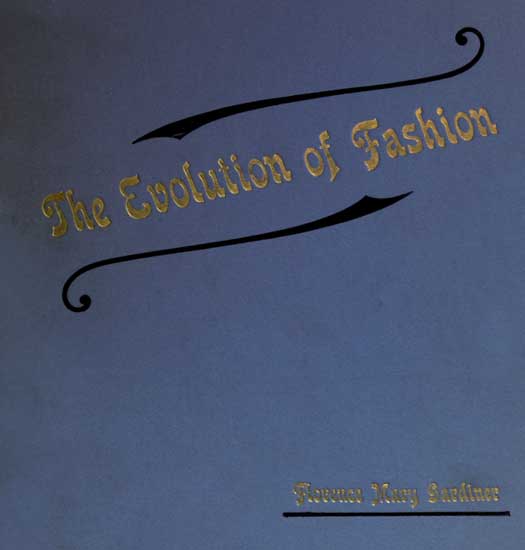
Project Gutenberg's The Evolution of Fashion, by Florence Mary Gardiner This eBook is for the use of anyone anywhere at no cost and with almost no restrictions whatsoever. You may copy it, give it away or re-use it under the terms of the Project Gutenberg License included with this eBook or online at www.gutenberg.org Title: The Evolution of Fashion Author: Florence Mary Gardiner Release Date: January 4, 2011 [EBook #34845] Language: English Character set encoding: ISO-8859-1 *** START OF THIS PROJECT GUTENBERG EBOOK THE EVOLUTION OF FASHION *** Produced by Meredith Bach and the Online Distributed Proofreading Team at http://www.pgdp.net

Author of "Furnishings and Fittings for Every Home," "About Gipsies," &c. &c.
 SIR ROBERT BRUCE COTTON.
SIR ROBERT BRUCE COTTON.
London:
THE COTTON PRESS, Granville House, Arundel Street, W.C.
Countess of Warwick,
whose enthusiastic and kindly interest in all movements
calculated to benefit women is unsurpassed,
This Volume,
by special permission, is respectfully dedicated,
by
in the year of
Her Majesty Queen Victoria's Diamond Jubilee,
1897.
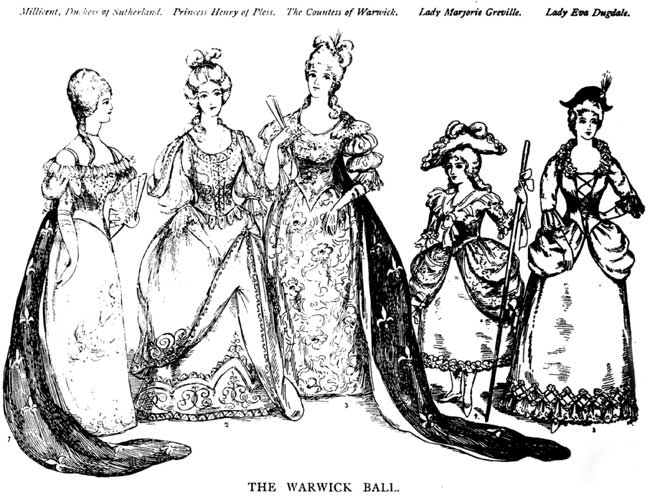
Millicent, Duchess of Sutherland. Princess Henry of Pless. The Countess of Warwick. Lady Marjorie Greville. Lady Eva Dugdale.
In compiling this volume on Costume (portions of which originally appeared in the Ludgate Illustrated Magazine, under the editorship of Mr. A. J. Bowden), I desire to acknowledge the valuable assistance I have received from sources not usually available to the public; also my indebtedness to the following authors, from whose works I have quoted:—Mr. Beck, Mr. R. Davey, Mr. E. Rimmel, Mr. Knight, and the late Mr. J. R. Planché. I also take this opportunity of thanking Messrs. Liberty and Co., Messrs. Jay, Messrs. E. R. Garrould, Messrs. Walery, Mr. Box, and others, who have offered me special facilities for consulting drawings, engravings, &c., in their possession, many of which they have courteously allowed me to reproduce, by the aid of Miss Juliet Hensman, and other artists.
The book lays no claim to being a technical treatise on a subject which is practically inexhaustible, but has been written with the intention of bringing before the general public in a popular manner circumstances which have influenced in a marked degree the wearing apparel of the British Nation.
West Kensington, 1897.
| CHAPTER. | PAGE. | |
| I. | The Dress, B.C. 594--A.D. 1897 | 3 |
| II. | Curious Headgear | 15 |
| III. | Gloves | 25 |
| IV. | Curious Footgear | 31 |
| V. | Bridal Costume | 39 |
| VI. | Mourning | 51 |
| VII. | Eccentricities of Masculine Costume | 61 |
| VIII. | A Chat about Children and their Clothing | 71 |
| IX. | Fancy Costume of Various Periods | 79 |
| X. | Stage and Floral Costume | 89 |
"Fashions that are now called new
Have been worn by more than you;
Elder times have used the same,
Though these new ones get the name."
Middleton's "Mayor of Quinborough."
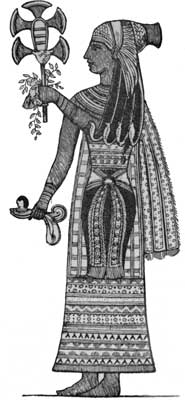 EARLY EGYPTIAN.
EARLY EGYPTIAN.
A hard fate has condemned human beings to enter this mortal sphere without any natural covering, like that possessed by the lower animals to protect them from the extremes of heat and cold. Had this been otherwise, countless myriads, for untold ages, would have escaped the tyrannical sway of the goddess Fashion, and the French proverb, il faut souffrir pour être belle, need never have been written.
The costume of our progenitors was chiefly remarkable for its extreme simplicity; and, as far as we can gather, no difference in design was made between the sexes. A few leaves entwined by the stalks, the feathers of birds, the bark of trees, or roughly-dressed skins of animals were probably regarded by beaux and belles of the Adamite period as beautiful and appropriate adornments for the body, and were followed by garments made from plaited grass, which was doubtless the origin of weaving, a process which is nothing more than the mechanical plaiting of hair, wool, flax, &c. In many remote districts these primitive fashions still prevail, as, for example, in Madras, where, at an annual religious ceremony, it is customary for the low caste natives to exchange for a short period their usual attire for an apron of leaves. In the Brazilian forests the lecythis, or "shirt tree," is to be found, from which the people roll off the bark in short lengths, and, after making it pliable in water, cut two slits for the arm-holes and one for the neck, when their dress is complete and ready for use. The North American Indian employs feathers for purposes of the toilet, and many African tribes are noted for their deftly-woven fabrics composed of grass and other vegetable fibres, while furs and skins are essential articles of dress in Northern latitudes. Perhaps the earliest specimen of a modiste's bill in existence has recently been found on a chalk tablet at Nippur, in Chaldea. The hieroglyphics record ninety-two robes and tunics: fourteen of these were perfumed with myrrh, aloes and cassia. The date of this curious antique cannot be less than two thousand eight hundred years before the Christian era. In ancient times it must be remembered that the principal seats of civilisation were Assyria and Egypt, and upon these countries Western nations depended for many of the luxuries of life. The Jews derived their fine fabrics from the latter[Pg 4] place, which was particularly noted for its linen manufactures and for magnificent embroideries, of which the accompanying illustration will give some idea. Medes and Babylonians, of the highest class, partially arrayed themselves in silk, which cost its weight in gold, and about the time of Ezekiel (B.C. 594) it is known to have been used in the dress of the Persians. It is a remarkable circumstance that this animal product was brought to the West manufactured in cloth, which was only half silk; and it is said the plan was devised of unravelling the stuff, which was rewoven into cloth of entire silk. Owing to its high price, the Romans forbade its being used for the entire dress by men, complete robes of silk being reserved for women. It is numbered among the extravagant luxuries of Heliogabalus that he was the first man who wore a silken garment, and the anecdote is well known of the Emperor Aurelian, who refused, on the ground of its extravagant cost, a silk dress which his consort earnestly desired to possess.
 GREEK.
GREEK.Monuments still in existence show that the Egyptians, owing to the warmth of their climate, were partial to garments of a semi-transparent character, while those living on the banks of the Tigris, who were subjected to greater extremes of temperature, wore clothing of similar design, but of wool, with heavy fringes of the same as a trimming. In some cases this feature of Assyrian costume is shown in double rows, one pendent, while the other stands out in a horizontal direction.
The early Greek dress, or chiton, was a very simple contrivance, reaching to the feet. If ungirdled, it would trail on the ground; but generally it was drawn through the zone or waistbelt in such a manner that it was double to the extent of about thirty inches over the vital organs of the body. The great distinction between male and female dress consisted in the length of the skirt. The trimmings were of embroidery, woven diapers, figure bands with chariots and horses; and, in some cases, glass ornaments and thin metal plates were applied. Among the working classes the chiton was, of course, homespun, or of leather.
The stola was the Roman equivalent for the nineteenth century robe or gown, and in many respects resembled the Greek chiton. The fabrics employed were wool and linen up to the end of the Republic, though at a later date, as has already been stated, silk was imported. Colour, under the Emperors, was largely used, and at least thirteen shades of the dye obtained from the murex, which passed under the general name of purple, could be seen in the costume of both sexes.
When the Roman Empire was dismembered (A.D. 395) a style of dress seems to have flourished in the important towns of the Mediterranean, which was similar to that worn in mediæval[Pg 5] times in Britain, and which may be examined in the specimens of statuary adorning tombs of the twelfth and thirteenth centuries. The semi-tight under-dress and sleeves appear to have been elaborately embroidered, and the loose mantle of plain material was edged with a border.
One of the earliest descriptions of the female dress in Britain is that of Boadicea, the Queen of the Iceni, whom we are told wore a tunic woven chequerwise in purple, red, and blue. Over this was a shorter garment open on the bosom, and leaving the arms bare. Her yellow hair flowed over her shoulders, upon which rested an ample cloak, secured by a fibula (brooch). A torque, or necklet, was also worn; a pair of bronze breastplates as a protection from the Roman arrows, and her fingers and arms were covered with rings and bracelets.
 BYZANTINE.
BYZANTINE.The costume of the Anglo-Saxon ladies consisted of a sherte, or camise, of linen next the skin, a kirtle, which resembled the modern petticoat, and a gunna, or gown, with sleeves. Out of doors a mantle covered the upper portion of the body, and with the coverchief, or head rail, formed a characteristic feature of the dress of the day. Cloth, silk, and linen were the favourite materials for clothing, and red, blue, yellow, and green the fashionable colours. Very little black and white were used at this period. Saxon women were renowned for their skill with the needle, and used large quantities of gold thread and jewels in their work. Among other instances quoted, Queen Editha embroidered the coronation mantle of her husband, Edward the Confessor.
For some years after the Norman Conquest, women retained the costume of the Anglo-Saxon period, with certain additions and modifications. Fine coloured cloths and richest furs were used by both sexes, and sleeves and trains were such a length that it was found necessary to knot them, so that they should not trail upon the ground.
The next important change was the surcoat and tight bodice, which was fastened in front to fit the figure.
There are evident traces that as civilisation advanced the love of dress and the desire of the fair sex to appear beautiful in the eyes of all beholders increased in like proportion. From ancient MSS. and other sources, we have ample proof of this. St. Jerome calls women "philoscomon," that is to say, lovers of finery, and another writer states: "One of the most difficult points to manage with women is to root out their curiosity for clothes and ornaments for the body." St. Bernard admonished his sister with greater candour than politeness on her visiting him, well arraied with riche clothinge, with perles and precious stones: "Such pompe and pride to adorne a carion as is youre body. Thinke ye not of the pore people, that be deyen for hunger and colde; and that for the sixth parte of youre gay arraye, forty persons might be clothed, refreshed, and kepte from the colde?"
The increased facilities for travelling offered to those engaged in the Crusades, and the necessary intercourse with[Pg 6] other nations, caused considerable quantities of foreign materials to be imported to England during the Middle Ages: and this had a corresponding effect upon the costume of the period, which was chiefly remarkable for its richness and eccentricity of form. Among the materials in use may be mentioned diaper cloth from Ypres, a town in Flanders, famous for its rich dress stuffs; tartan, called by the French "tyretaine," meaning teint, or colour of Tyre (scarlet being indifferently used for purple by ancient writers, and including all the gradations of colour formed by a mixture of blue and red, from indigo to crimson). There was a fine white woollen cloth called Blanket, named after its inventor, Sarcenet, also from its Saracenic origin, and gauze which was made at Gaza in Palestine. Ermine was strictly confined to the use of the Royal Family and nobles, and cloth of gold, and habits embroidered with jewellery, or lined with minever or other expensive fur, could only be worn by knights and ladies with incomes exceeding 400 marks per annum. Those who had not more than 200 marks were permitted to wear silver cloth, with ribands, girdles, &c., reasonably embellished; also woollen cloth not costing more than six marks the piece.
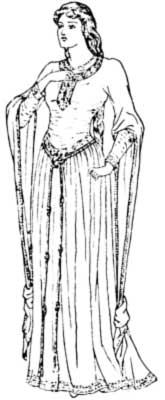 12TH CENTURY.
12TH CENTURY.
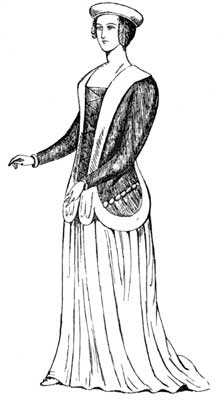 14TH CENTURY.
14TH CENTURY.
The tight forms of dress now in common use among women were an incentive to tight lacing, an injurious practice, from which their descendants suffer. A lady is described
"Clad in purple pall,
With gentyll body and middle small,"
and another damsel, whose splendid girdle of beaten gold was embellished with emeralds and rubies, evidently, from the description, had a waist which was not the size intended by Nature.
During the Wars of the Roses both trade and costume made little progress, and after the union of the Houses of York and Lancaster by the marriage of Henry VII. with his Queen, Elizabeth, their attention was chiefly concerned in filling their impoverished coffers, which left them little opportunity for promoting new fashions in dress. Henry VIII. afforded ample facilities for the revival of the trade in dress goods, and there is little[Pg 7] difficulty in tracing female costume of the sixteenth century when we remember that in the course of thirty-eight years he married six wives, besides having them painted times without number by all the popular artists of the day.
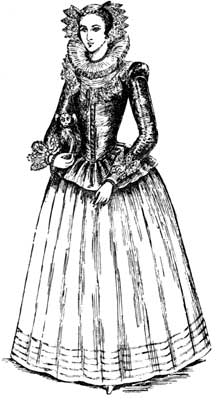 16TH CENTURY. From Portrait of Mary Queen of Scots.
16TH CENTURY. From Portrait of Mary Queen of Scots.
J. R. Planché in his "History of British Costume," says: "The gowns of the nobility were magnificent, and at this period were open in front to the waist, showing the kirtle, or inner garment, as what we should call the petticoat was then termed." Anne of Cleves, who found so little favour in Henry's eyes, is said to have worn at their first interview "a rich gowne of cloth of gold made round, without any train, after the Dutch fashion;" and in a wardrobe account of the eighth year of this Bluebeard's reign appears the following item: "Seven yards of purple cloth of damask gold for a kirtle for Queen Catherine of Arragon." The dress of Catherine Parr is thus described by Pedro de Gante, secretary to the Spanish Duke de Najera, who visited Henry VIII. in 1543-1544: "She was robed in cloth of gold, with a 'saya' (petticoat) of brocade, the sleeves lined with crimson satin and trimmed with three-piled crimson velvet. Her train was more than two yards long." Articles of dress were often bequeathed by will. In one made on the 14th of August, 1540, William Cherington, yeoman, of Waterbeche, leaves "To my mother my holyday gowne." Nicholas, Dyer of Feversham, 29th October, 1540, "To my sister, Alice Bichendyke, thirteen shillings and ninepence which she owed me, and two kerchiefs of holland." John Holder, rector of Gamlingay, in 1544 leaves to Jane Greene "my clothe frock lined with satin cypress." These entries are from wills in the Ely Registry.
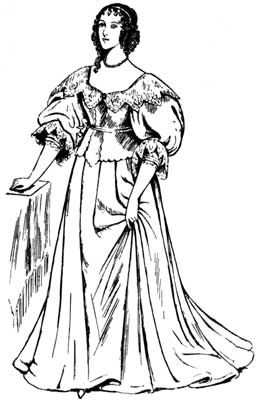 17TH CENTURY.
17TH CENTURY.
A peculiar feature in the costume of both sexes was sleeves distinct from the gown, but attached (so as to be changed at pleasure) to the waistcoat. Among the inventories we find three pairs of purple satin sleeves for women, one pair of linen sleeves paned with gold over the arm, quilted with black silk and wrought with flowers; one[Pg 8] pair of sleeves of purple gold tissue damask wire, each one tied with aglets of gold; one pair of crimson satin sleeves, four buttons of gold being set on each, and in every button nine pearls.
We are all familiar with the distended skirts, jewelled stomachers and enormous ruffs which adorned the virgin form of Good Queen Bess. In the middle of her reign the body was imprisoned in whalebone, and the fardingale, the prototype of the modern hoop, was introduced, as it was not to be supposed that a lady who is said to have left three thousand dresses in her wardrobe would remain faithful to the fashions of her grandmother; and Elizabeth's love of dress permeated all classes of society.
The portrait of Mary Queen of Scots, who was considered an authority on matters of the toilet, and whose taste for elegance of apparel had been cultivated to a high degree during her residence at the French Court is given. There is a subtlety and charm about it which is wanting in the costume of her cousin Elizabeth, and it may be considered a fair type of what was worn by a gentlewoman of that period. The full skirt appears to fall in easy folds, and the basqued bodice, with tight sleeves, is closely moulded to the figure and surmounted by an elaborately-constructed ruff of muslin and lace.
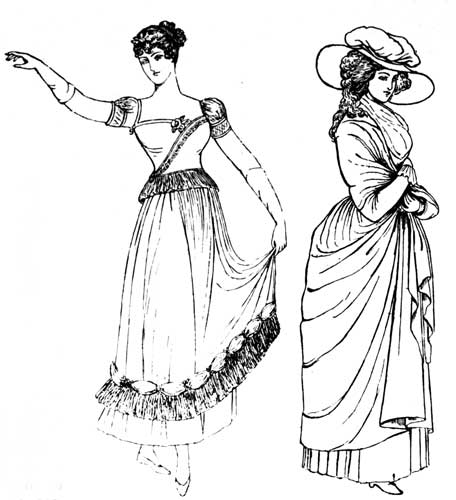
19TH CENTURY. BALL DRESS, 1809. 18TH CENTURY. WALKING COSTUME.
To the great regret of antiquarians, the wardrobes of our ancient kings, formerly kept at the Tower, were by the order of James I. distributed. At no period was the costume of Britain more picturesque than in the middle of the seventeenth century, and we naturally turn to its great delineators Velasquez, Van Dyck, Rembrandt, and Rubens, who delighted in giving us such fine examples of their work. Women had grown tired of the unwieldy fardingale, and changed it for graceful gowns with flowing skirts and low bodices, finished with deep vandyked collars of lace or embroidery.
A studied negligence, an elegant déshabillé prevailed in the Stuart Court, particularly after the Restoration. Charles II.'s bevy of beauties are similarly attired, and the pictures in Hampton Court show us women whose snowy necks and arms are no longer veiled, and whose gowns of rich satin, with voluminous trains, are piled up in the background. Engravings and drawings which may be seen in every printseller's window make special illustrations of this period unnecessary.
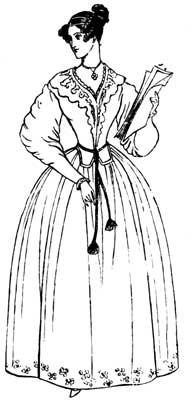 19TH CENTURY.—TEA DRESS, 1830.
19TH CENTURY.—TEA DRESS, 1830.
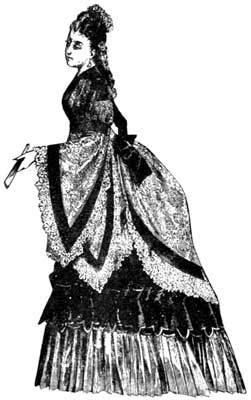 19TH CENTURY.—THE POLONAISE, 1872.
19TH CENTURY.—THE POLONAISE, 1872.
Dutch fashions appear to have followed in the wake of William and Mary. Stomachers and tight sleeves were once more in favour, and fabrics of a rich and substantial character were employed in preference to the softer makes of silk, which lent itself so well to the soft flowing lines of the previous era.
An intelligent writer has remarked "that Fashion from the time of George I. has been such a varying goddess that neither history, tradition, nor painting has been able to preserve all her mimic forms; like Proteus struggling in the arms of Telemachus, on the[Pg 9] Phanaic coast, she passed from shape to shape with the rapidity of thought." In 1745 the hoop had increased at the sides and diminished in front, and a pamphlet was published in that year entitled "The enormous abomination of the hoop petticoat, as the fashion now is." Ten years later it is scarcely discernible in some figures, and in 1757 reappears, extending right and left after the manner of the court dress of the reign of George III. For the abolition of this monstrosity we are indebted to George IV., and ladies' dresses then rushed to the other extreme. Steel and whalebone was dispensed with, and narrow draperies displayed the form they were supposed to conceal, and were girdled just below the shoulders.
These were in time followed by the bell-shaped skirts worn at the accession of Her Majesty Queen Victoria, during whose reign fashion has indeed run riot. The invention of the sewing machine was the signal for the appearance of frills and furbelows, and meretricious ornament of every kind. In the middle of the present century crinolines were again to the fore, skirts were proportionately wide and generally flounced to the top. The bodice terminated at the waist with a belt; but in some cases a Garibaldi, or loose bodice of different texture, was substituted. The next change to be noted was that hideous garment the "polonaise," which was a revival of, and constructed on similar lines to, the "super froc" of the Middle Ages. For many years English ladies, with a supreme disregard for the appropriate, wore this with a skirt belonging to an entirely different costume. But at last people got nauseated with these abominations, and under the gentle sway and influence of "Our Princess" a prettier, more useful and rational costume appeared. In 1876 the graceful Princess dress, which accentuated every good point in the figure, was generally worn; and though this costume in the latter part of its career was fiercely abused by the rotund matron and Mrs. Grundy, for clinging too closely to the lines of the human form, it was distinctly an advance as regards health and beauty on the varying styles which preceded it.
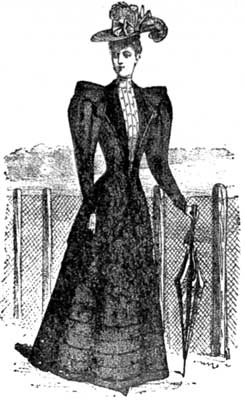 TAILOR-MADE DRESS, 1897.
TAILOR-MADE DRESS, 1897.
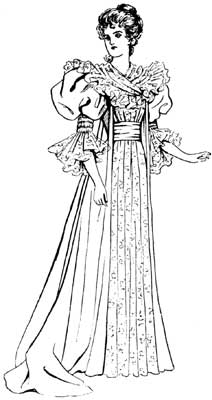 TEA GOWN, 1897.
TEA GOWN, 1897.
The æsthetic movement has also had a marked influence on our taste in all directions, but more especially in the costume of the last few years; and though the picturesque garb of the worshippers of the sunflower and the lily may not be adapted to the wear and tear of this workaday world, it is beautiful in form and design, incapable of undue pressure; and for children and young girls it would be difficult to imagine a more charming, artistic, and becoming costume.
Once more we are eschewing classical lines for grotesque which makes caricatures of lovely women, and drives plain ones to despair. The subdued and delicate tints which a few seasons since were regarded with favour have been superseded by garish shades and bright colours, which seem to quarrel with everything in Nature and Art. Unfortunately, we English are prone to extremes, and possess the imitative rather than the creative faculty. Consequently, our national costume is seldom distinctive, but a combination of some of the worst styles of our Continental neighbours, who would scorn to garb themselves with so little regard for fitness, beauty, and the canons of good taste.
Two dominant notes, however, have been struck in the harmonies of costume during the last twenty-five years—the tailor-made dress, which may almost be regarded as a national livery; and the tea gown, that reposeful garment to which we affectionately turn in our hours of ease. How well each in its way is calculated to serve the purpose for which it is designed, the simple cloth, tweed, or serge costume moulded to the lines of the figure, adapted to our changeful climate, and giving a cachet to the wearer, not always found in much more costly apparel, a rational costume in the best sense of the word, and one which women of all ages may assume with satisfaction to themselves and to those with whom[Pg 11] they come in contact. The tea gown, on the other hand, drapes the figure loosely so as to fall in graceful folds, and may be regarded as a distinct economy, as it so often takes the place of a more expensive dress. Beauty, which is one of Heaven's best gifts to women, is useless unless appropriately framed, and a well-known exponent on the art of dressing artistically, has laid down the axiom that harmonies of colour are more successful than contrasts. If we turn to Nature we have an unfailing source of inspiration. The foliage tints, sunset effects, the animal and mineral worlds all offer schemes of colour, which can be readily adapted to our persons and surroundings. And to look our best and, above all, to grow old gracefully, is a duty which every daughter of Eve owes to humanity. The manner in which so many women give way early in life is simply appalling. While still in the bloom of womanhood they assume the habits and dress of decrepitude, submit to be placed on the social shelf without a murmur, and calmly allow those slightly their junior, and in some cases their senior, to appropriate the good things of life, and to monopolise the attention of all and sundry. Mothers in their prime willingly allow anyone who can be persuaded to do so, to chaperone their daughters, and to pilot them through the social eddies and quicksands of their first season, and through sheer indolence fail to exercise the lawful authority and responsibility which maternity entails. The unmarried woman, conscious that she is no longer in her first youth, and indifferent to the charms of maturity, takes to knitting socks in obscure corners, and assumes an air of self-repression and middle-agedness which apparently takes[Pg 12] ten years from her span of existence, and conveys to the casual onlooker, that she has passed the boundary line between youth and old age. Why should these women sink before their time into a slough of dowdyism and cut themselves off from the enjoyments civilisation has provided for their benefit?
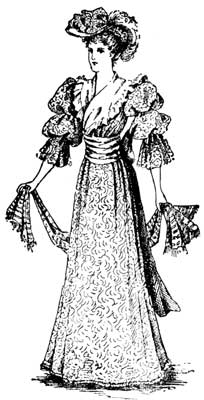 AN ARTISTIC DRESS, 1897.
AN ARTISTIC DRESS, 1897.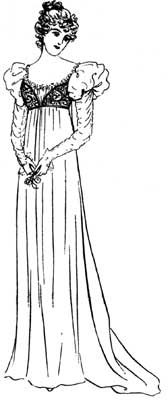 MODERN EVENING DRESS.
MODERN EVENING DRESS.
Equally to be deprecated are those who cling so desperately to youth that they entirely forget the later stages of life have their compensations. Women who in crowded ballrooms display their redundant or attenuated forms to the gaze of all beholders, whose coiffure owes more to art than nature, and who comfort themselves with the conviction that in a carefully shaded light rouge and pearl powder are hardly distinguishable from the bloom of a youthful and healthy complexion. A variety of circumstances combine to bring into the world a race of people who cannot strictly lay claim to beauty, but who nevertheless have many good points which might be accentuated, while those that are less pleasing could be concealed. A middleaged woman will respect herself and be more respected by others if she drapes her person in velvet, brocade, and other rich fabrics which fall in stately folds, and give her dignity, than if she persists in decking herself in muslin, crepon, net, and similar materials, because in the long since past they suited her particular style. Gossamers belong to the young, with their dimpled arms, shoulders of snowy whiteness, and necks like columns of ivory. Their eyes are brighter than jewels, and their luxuriant locks need no ornament save a rose nestling in its green leaves, a fit emblem of youth and beauty.
With the education and art training at present within the grasp of all classes of the community there is nothing to prevent our modifying prevailing fashions to our own requirements; and common sense ought to teach us (even if we ignore every other sentiment which is supposed to guide reasoning creatures) that one particular style cannot be appropriate to women who are exact opposites to each other. If each person would only think out for herself raiment beautiful in form, rich in texture, and adapted to the daily needs of life, we should be spared a large number of the startling incongruities which offend the eye in various directions.[Pg 13]
"Here in her hair
The painter plays the spider, and hath woven
A golden mesh to entrap the hearts of men
Faster than gnats in cobwebs."
The Merchant of Venice.
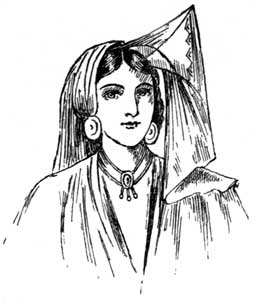 ANCIENT JEWISH HEAD-DRESS.
ANCIENT JEWISH HEAD-DRESS.
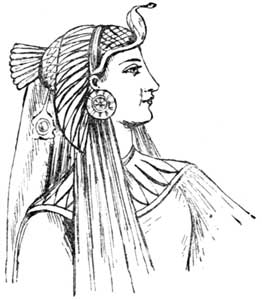 EGYPTIAN HEAD-DRESS.
EGYPTIAN HEAD-DRESS.
Holy Writ simply teems with allusions to the luxurious tresses of the fair daughters of the East, and there is little doubt that at an early period in the world's history women awakened to the fact that a well-tired head was a very potent attraction, and had a recognised market value. Jewish women were particularly famed in this respect, and employed female barbers, who, with the aid of crisping pins, horns, and towers, prepared their clients for conquest. These jewelled horns were generally made of the precious metals, and the position denoted the condition of the wearer. A married woman had it fixed on the right side of the head, a widow on the left, and she who was still an unappropriated blessing on the crown. Over the horn the veil was thrown coquettishly, as in the illustration. Assyrian women delighted in long ringlets, confined by a band of metal, and the men were not above the weakness of plaiting gold wire with their beards. Rimmel, in "The Book of Perfumes," relates a curious anecdote of Mausolus, King of Caria, who turned his people's fondness for flowing locks to account when his exchequer required replenishing. "Having first had a quantity of wigs made and stored in the royal warehouses, he published an edict compelling all his subjects to have their heads shaved. A few days after, the monarch's agents went round, offering them the perukes destined to cover their denuded polls, which they were delighted to buy at any price". It is not surprising that Artemisia could not console herself for the loss of such a clever husband, and that, not satisfied with drinking his ashes dissolved in wine, she spent some of her lamented lord's ill-gotten revenue in building such a monument to his memory that it was counted one of the wonders of the world.
The Egyptians were also partial to wigs, some of which are still preserved in the British Museum. Ladies wore a multitude of small plaits and jewelled head-pieces resembling peacocks and other animals, which contrasted with their dark tresses with brilliant effect; or a fillet ornamented with a lotus bud. The coiffure of a princess was remarkable for its size and the abundance of animal, vegetable, and mineral treasures with which it was adorned. In Egyptian tombs and elsewhere have been discovered small[Pg 16] wooden combs resembling the modern tooth-comb, and metal mirrors of precisely the same shape as those in use at the present day, as well as numerous other toilet appliances.
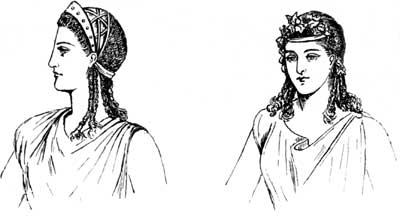 ANCIENT GRECIAN. ANCIENT ROMAN.
ANCIENT GRECIAN. ANCIENT ROMAN.
Grecian sculpture affords us the opportunity of studying the different modes in favour in that country, and it is astonishing to find what a variety of methods were adopted by the belles of ancient Greece for enhancing their charms. A loose knot, fastened by a clasp in the form of a grasshopper, was a favourite fashion. Cauls of network, metal mitres of different designs, and simple bands, and sometimes chaplets, of flowers, all confined at different periods, the luxuriant locks of the Helens, Penelopes, and Xantippes of ancient times.
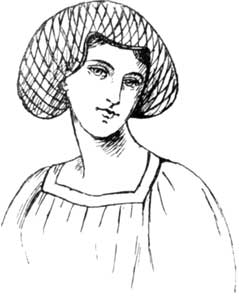 ENGLISH HEAD-DRESS OF THE 13TH CENTURY.
ENGLISH HEAD-DRESS OF THE 13TH CENTURY.
It was a common custom among heathen nations to consecrate to their gods the hair when cut off, as well as that growing on the head, and it was either consumed on the altar, deposited in temples, or hung upon the trees. A famous instance of the consecration of hair is that of Berenice, the wife of Ptolemy Evergetes. It is related that when the king went on his expedition to Syria, she, solicitous for his safety, made a vow to consecrate her hair (which was remarkable for its fineness and beauty) to Venus, if he returned to her. When her husband came back she kept her word, and offered her hair in the temple of Cyprus. This was afterwards missing, when a report was spread that it had been turned into a constellation in the heavens, which constellation, an old writer tells us, is called Coma Berenices (the hair of Berenice) to the present day. Another remarkable instance is that of Nero, who, according to Suetonius, cut off his first beard, put it in a casket of gold set with jewels, and consecrated it to Jupiter Capitolinus.
The hair of the head and beard appears to have been held in great respect by most nations, and perhaps we may trace the use of human hair in spells and incantations to this fact. Orientals especially treat the hair which falls[Pg 17] from them with superstitious care, and bury it, so that no one shall use it to their prejudice.
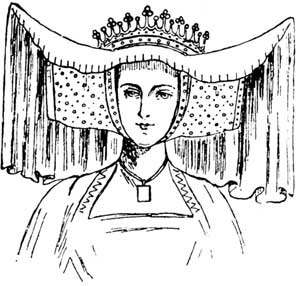 HORNED HEAD-DRESS OF 15TH CENTURY.
HORNED HEAD-DRESS OF 15TH CENTURY.
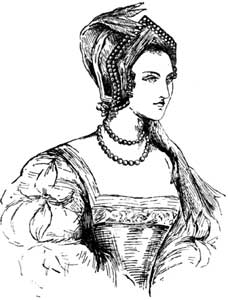 STEEPLE HEAD-DRESS OF 15TH CENTURY.
STEEPLE HEAD-DRESS OF 15TH CENTURY.
Roman matrons generally preferred blonde hair to their own ebon tresses, and resorted to wigs and dye when Nature, as they considered, had treated them unkindly. Ovid rebukes a lady of his acquaintance in the plainest terms for having destroyed her hair.
"Did I not tell you to leave off dyeing your hair? Now you have no hair left to dye: and yet nothing was handsomer than your locks: they came down to your knees, and were so fine that you were afraid to comb them. Your own hand has been the cause of the loss you deplore: you poured the poison on your own head. Now Germany will send you slaves' hair—a vanquished nation will supply your ornament. How many times, when you hear people praising the beauty of your hair, you will blush and say to yourself: 'It is bought ornament to which I owe my beauty, and I know not what Sicambrian virgin they are admiring in me. And yet there was a time when I deserved all these compliments.'"
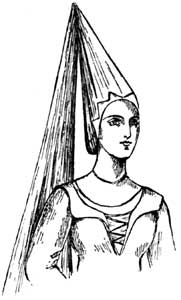 EARLY TUDOR HEAD-DRESS.
EARLY TUDOR HEAD-DRESS.
It would puzzle any fin de siècle husband or brother to express his displeasure in more appropriate words than those chosen by the poet.
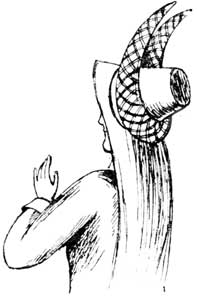 HORNED HEAD-DRESS OF EDWARD IV.'s REIGN.
HORNED HEAD-DRESS OF EDWARD IV.'s REIGN.
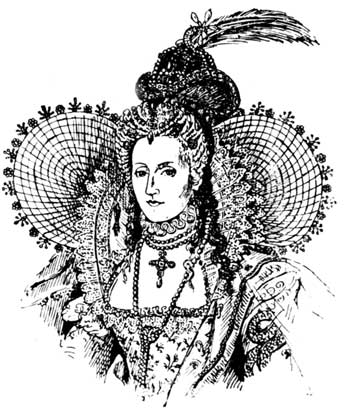 ELIZABETHAN HEAD-DRESS.
ELIZABETHAN HEAD-DRESS.
The Britons, before they mixed with other nations, were a fair-haired race, and early[Pg 18] writers referred to their washing their auburn tresses in water boiled with lime to increase the reddish colour. Boadicea is described with flowing locks which fell upon her shoulders; but after the Roman Invasion the hair of both men and women followed the fashion of the conquerors.
From Planché's "History of British Costume," we learn that "the female head-dress among all classes of the Anglo-Saxons was a long piece of linen or silk wrapped round the head and neck." It appears to have been called a head-rail, or wimple, but was dispensed with in the house, as the hair was then as cherished an ornament as at the present day. A wife described by Adhelm, Bishop of Sherborne, who wrote in the eighth century, is said to have had "twisted locks, delicately curled by the iron;" and in the poem of "Judith" the heroine is called "the maid of the Creator, with twisted locks." Two long plaits were worn by Norman ladies, and were probably adopted by our own countrywomen after the Conquest.
During the Middle Ages feminine head-gear underwent many changes. Golden nets, and linen bands closely pinned round the hair and chin, were followed by steeple-shaped erections and horned head-dresses in a variety of shapes, of which the accompanying sketches will give a better idea than any written description.
During the sixteenth century matrons adopted either a pointed hood, composed of velvet or other rich fabric, often edged with fur, a close-fitting coif, or the French cap to be seen in the portraits of the unhappy Mary Stuart. Those who were unmarried had their hair simply braided and embellished with knots of ribbon, strings of pearls, or Nature's most beautiful adornment for the maiden—sweet-scented flowers.
The auburn tresses of Her Gracious Majesty Queen Elizabeth, were always bien coiffée, if we may judge from her various portraits. She scorned the hoods, lace caps, and pointed coifs, worn by her contemporaries, and adopted a miniature crown or jaunty hat of velvet, elaborately jewelled. Her fair complexion and light hair were thrown into relief by ruffles of lace, and this delicate fabric was stretched over fine wire frames, which met at the back, and remotely suggested the fragile wings of the butterfly, or the nimbus of a saint, neither of which ornaments was particularly appropriate to the lady in question. The front hair was turned over a cushion, or dressed in stiff sausage-[Pg 19]like curls, pinned close to the head, and was adorned with strings and stars of flashing gems and a pendant resting on the forehead.
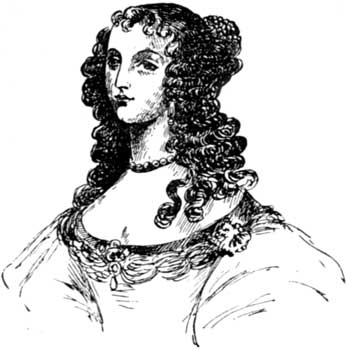 A BEAUTY OF THE COURT OF CHARLES II.
A BEAUTY OF THE COURT OF CHARLES II.
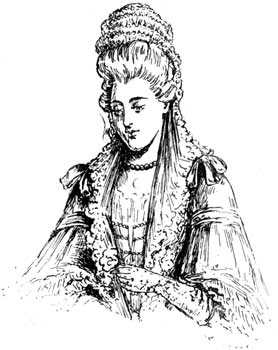 END OF 17TH CENTURY.
END OF 17TH CENTURY.
That splendid historian, Stubbs, who has left us such minute particulars of the fashions of his time, quaintly describes the coiffure of the ladies of the Court. He states: "It must be curled, frizzled, crisped, laid out in wreaths and borders from one ear to the other, and lest it should fall down, must be underpropped with forkes and weirs, and ornamented with gold or silver curiously wrought. Such gewgaws, which being unskilful in woman's tearms, I cannot easily recount. Then upon the toppes of their stately turrets, stand their other capital ornaments: a French hood, hatte, cappe, kircher and suchlike, whereof some be of velvet, some of this fashion and some of that. Cauls made of netwire, that the cloth of gold, silver, or tinsel, with which their hair was sometimes covered, might be seen through; and lattice caps with three horns or corners, like the forked caps of popish priests." The Harleian MSS., No. 1776, written in the middle of Elizabeth's reign, refers to an ordinance for the reformation of gentlewomen's head-dress, and says: "None shall wear an ermine or lattice bonnet unless she be a gentlewoman born, having Arms." This latter phrase, we may conclude, refers to armorial bearings, not to physical development.
The wearing of false hair and periwigs was left to the sterner sex for some years after the restoration of the House of Stuart, and women were satisfied with well-brushed ringlets escaping from a bandeau of pearls, or beautified by a single flower. The hair was often arranged in small, flat curls on the forehead, as in the sketch of a Beauty of the Court of Charles II.; and this fashion had a softening effect on the face, and was known as the "Sevigné style."
Dutch fashions naturally prevailed in the Court of William and Mary, and this queen is represented with a high muslin cap, adorned with a series of upright frills, edged with lace, and long lappets falling on the shoulders. Farquhar, in his comedy "Love and the Bottle," alludes to the "high top-knots," and Swift, to the "pinners edged with colberteen," as the lace streamers were called. About this period the hair was once again rolled back from the face, and assumed enormous dimensions, so much so, that in some cases it was found necessary to make doorways broader and higher than they had hitherto been, to allow fashionably-dressed ladies to pass through without displacing the elaborate erections they carried. Stuffed with horsehair, clotted with pomade and[Pg 20] powder, and decked with every conceivable ornament, from a miniature man-of-war in full sail, to a cooing dove with outspread wings, presumably sitting on its nest, or a basket of flowers wreathed with ribbons. Naturally, the aid of the barber was called in, as ladies were incapable of constructing and manipulating such a mass of tangled locks. We may imagine, on the score of expense and for other reasons, the hair was not dressed so frequently as cleanliness demanded, for in a book on costume a hairdresser is described as asking one of his customers how long it was since her hair had been opened and repaired. On her replying, "Nine weeks," he mildly suggested that that was as long as a head could well go in summer, "and, therefore, it was proper to deliver it now, as it began to be a little hazarde." Various anecdotes of this nature make us feel that personal hygiene was a matter of secondary importance to our ancestors.
Planché, in his work on British Costume, informs us that powder maintained its ground till 1793, when it was discarded by Her Majesty Queen Charlotte, Consort of George III., and the Princesses.
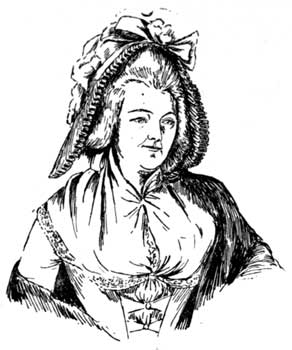 FASHIONABLE COIFFURE OF AN ELDERLY LADY IN THE 18TH
CENTURY.
FASHIONABLE COIFFURE OF AN ELDERLY LADY IN THE 18TH
CENTURY.
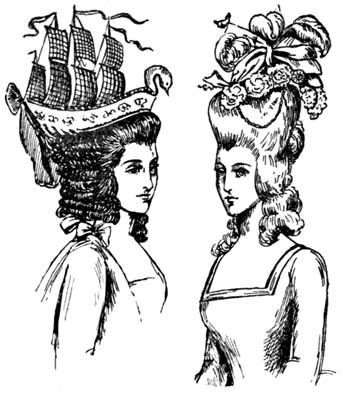 FASHIONABLE HEAD-DRESSES IN THE TIMES OF THE GEORGES.
FASHIONABLE HEAD-DRESSES IN THE TIMES OF THE GEORGES.
Varied, indeed, have been the fashions of the 19th century, the close of which is fast approaching. Only a few of the styles adopted can be briefly touched upon, and, naturally, those will be selected which form the greatest contrast to each other. The belle of 1830 was distinguished by upstanding bows of plain or plaited hair, arranged on the crown of the head, and the front was generally in bands or short ringlets, held in place by tortoise-shell side-combs. The simplicity of this coiffure was compensated for by the enormous size of the hats and bonnets generally worn with it. These had wide and curiously-shaped brims, over which was stretched or gathered silk, satin, aerophane, or similar materials. Garlands and bunches of flowers and feathers were used in profusion, and bows and strings of gauze ribbon floated in the wind. In this bewitching costume were our grandmothers wooed and won by suitors who evidently, from the impassioned love letters still in existence, believed them to be perfect types of loveliness.
Towards the middle of Queen Victoria's reign, the hair was dressed in a simple knot, and the front[Pg 21] arranged in ringlets, which fell gracefully on the chest and shoulders. Even youthful married ladies, in the privacy of their homes and for morning dress, were expected, by one of those potent but unwritten laws of the fickle goddess Fashion, to wear muslin or net caps, with lace borders, embellished with ribbons.
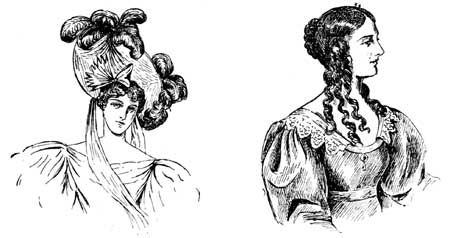 1830. 1855.
1830. 1855.
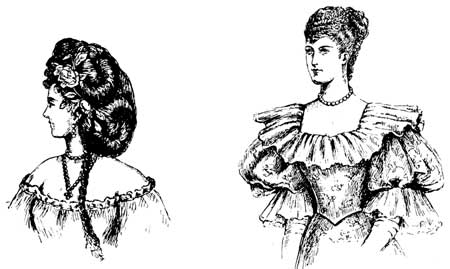 BIRD'S-NEST CHIGNON, 1872. PRESENT DAY, 1894.
BIRD'S-NEST CHIGNON, 1872. PRESENT DAY, 1894.
The labours of Hercules would be mere child's play compared to giving a faithful record of the chameleon-like changes which have affected that kaleidoscope, public taste, during the last forty years, and a very limited study of this fascinating subject at once convinces us that, whatever peculiarities may appear, they are certain to be revivals or[Pg 22] modifications of styles favoured by our more or less remote ancestors.
In 1872 loomed upon us that ghastly horror the chignon, which bore a faint resemblance to the exaggerated coiffures of the 18th century. Upon this monstrous edifice, with its seductive Alexandra curl, were tilted bonnets so minute that they were almost invisible in the mountains of hair that surrounded them. These were replaced by hats à la Chinois, like shallow plates; while for winter wear, others of fur or feathers were introduced, with an animal's head fixed firmly on the brow of the wearer, and resembling nothing so much as the fox foot-warmer, with which ladies now keep their pedal extremities at a proper temperature when enjoying an airing. Besides these, there were pinched canoes turned keel uppermost, and flexible mushrooms, which flapped and caught the wind till it was necessary to attach a string to the edge, to keep them snug and taut; such hats as Leech has immortalised in his sketches. Turbans and facsimiles of the delicious but indigestible pork-pie, Gainsborough, Rousby, and Langtry hats, all named after styles worn by their respective namesakes; and hats made of straw, leghorn, crinoline, lace, satin, and of silver and gold tissue, of every shape and size that fancy could devise, or the heart of the most exacting woman of fashion could desire. The hair beneath was dressed like the frizzy mop illustrated, in plaited wedges flowing like a pendant hump half-way down the back, or in a cascade of curls reaching from the crown of the head to the waist. These were followed by gigantic rolls at the back of the skull, Grecian knots, varying from the dimensions of a door handle to those of a cottage loaf, and latterly by that hideous monstrosity, the "bun." Another turn of the wheel of fashion has given us a simple mode of dressing the hair, which is well adapted to the average English head, and which is fully explained by the accompanying sketch. It may be taken as a safe rule, when the forehead is low and face small, that the hair may be drawn back with advantage, but a long face is generally improved by arranging the hair in soft curls on the forehead, and by waving it slightly at the sides, which adds to the apparent width of the countenance. But whatever style is in fashion, it is sure to have its admirers, for has not Pope left on record:
"Fair tresses man's imperial race ensnare,
And beauty draws us by a single hair."
[Pg 23]
"Gloves as sweet as damask roses."—Shakespeare.
"See how she leans her cheek upon her hand.
O, that I were a glove upon that hand,
That I might touch that cheek."
—Romeo and Juliet.
The glove as an article of dress is of great antiquity, and among the fossils of the cave-dwellers of pre-historic times, which have been recently discovered in France, Belgium, and Switzerland, there is ample proof of its existence. Probably the first gloves were formed of skins, sewn with bone needles, and were long enough to reach above the elbow.
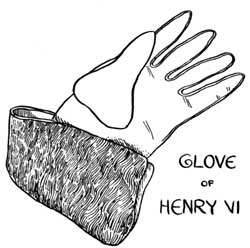 GLOVE OF HENRY VI
GLOVE OF HENRY VI
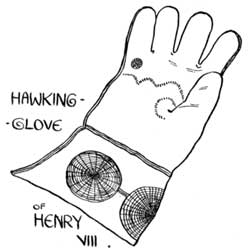 HAWKING-GLOVE OF HENRY VIII.
HAWKING-GLOVE OF HENRY VIII.
Xenophon, speaking of the Persians, gives as an instance of their effeminacy "that they not only covered their head and feet, but guarded their hands from cold by thick gloves." Homer, describing Laërtes at work in his garden, represents him with gloves on his hands to protect them from thorns. Pliny the younger, in speaking of his uncle's visit to Vesuvius, states that his secretary sat by ready to write down anything that was remarkable, and had gloves on his hands that the coldness of the weather need not impede his work. Varro, an ancient writer says:—"Olives gathered with the naked hand are preferable to those plucked in gloves;" and Atheneus speaks of a glutton who wore gloves at table so that he might handle the meat while hot and devour more than the others present.
That the Anglo-Saxons wore gloves we gather from their being mentioned in an old romance of the seventh century known as the "Poem of Beowulf," and according to the laws of Ethelred the Unready, five pairs of gloves formed part of the duty paid to that Prince by certain German merchants. In Planché's "History of British Costume," an Anglo-Saxon lady appears to be wearing a glove with a separate division for the thumb but without fingers, and exactly resembling an infant's glove of the present day. In 1462 Edward IV. forbade the importation of foreign gloves to England, a law which remained in force till 1826.
In the early Christian Church gloves played an important part. In A.D. 790 Charlemagne granted an unlimited right of hunting to the Abbot and monks of Sithin, so that the skins of the deer they killed could be used in the manufacture of gloves, girdles, and covers of books. In some cases it was commanded that the clergy should wear gloves in administering the Sacrament, and a writer in the "Antiquary" states:—"It was always looked upon as decorous for the laity to take off their gloves in church where ecclesiastics alone might wear them. It was perhaps regarded as a proof of clean[Pg 26] hands, for to this day persons sworn in our law courts are compelled to remove their gloves." In the ancient Consecration Service for the Bishops of the Church, a blessing was invoked on the gloves they wore. Those of William of Wykeham preserved at New College, Oxford, are adorned with the sacred monogram in red silk, and ecclesiastical gloves were often lavishly decorated with embroidery and jewels, and were bequeathed by will with other valuables.
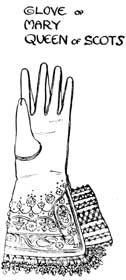 GLOVE OF MARY QUEEN OF SCOTS
GLOVE OF MARY QUEEN OF SCOTS
Formerly judges were forbidden to wear gloves when engaged in their official duties, but are no longer bound by this restriction, and receive as a memorial of a maiden assize (that is, when there are no prisoners to be tried) a pair of white kid gloves from the sheriff, and during the time fairs were held their duration was marked by hanging a glove outside the town hall. As long as it remained there all persons in the place were exempt from arrest, but directly it was removed it was the signal for closing the fair, and the privilege was at an end.
Throwing down a glove was regarded as a challenge to combat, and this curious old custom is still retained in the English coronation ceremony. Kings were also invested with authority by the delivery of a glove. As un gage d'amour it has for centuries been esteemed, and in the days of chivalry it was usual for knights to wear their ladies' gloves in their helmets, as a talisman of success in arms. In old records we also meet with the term "glove money," a sum paid to servants with which they were to provide this portion of their livery, and till quite recently it was the custom to present those who attended weddings and funerals with gloves as a souvenir.
Shakespeare often mentions gloves, and some assert that he was the son of a glover. A pair which belonged to the dramatist is still preserved. They are of brown leather, ornamented with a stamped pattern, and are edged with gold fringe. They were presented by the actor Garrick to the Mayor and Corporation of Stratford-on-Avon at the Shakespearian commemoration in 1789.
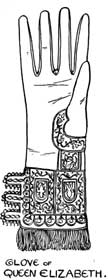 GLOVE OF QUEEN ELIZABETH.
GLOVE OF QUEEN ELIZABETH.
Many royal gloves have found a place in private collections. Henry VI.'s glove has a gauntlet, is made of tanned leather, and is lined with deer-skin, and the hawking glove of Henry VIII. is another interesting relic of[Pg 27] a bygone age. The King kept his hawks at Charing Cross, and in the inventories taken after this monarch's death we read of "three payre of hawkes' gloves, with two lined with velvet;" and again at Hampton Court there were "seven hawkes' gloves embroidered." The hawking glove, of which an illustration is given, may be seen in the Ashmolean Museum. It is of a simple character, evidently intended for use rather than ornament.
Gloves were not generally worn by women till after the Reformation; but during the sixteenth and seventeenth centuries their use gradually extended to the middle classes. Queen Elizabeth's glove may be seen at the Bodleian Library, Oxford, and is believed to have been worn at the visit of the Virgin Queen to the University in 1566. It is fringed with gold, and is nearly half a yard in length; it is made of white leather worked with gold thread, and the cuff is lined with drab silk. Mary Queen of Scots' glove in the Saffron Walden Museum is of light buff leather, wrought with silver wire and silk of different colours. It is lined with crimson satin, edged with gold lace enriched with sequins, and the opening is connected with bands of satin finished with lace insertion. This glove was presented on the morning of her execution to a member of the Dayrell family, who was in attendance at Fotheringay Castle. In happier days Queen Mary gave an exquisitely embroidered pair of gloves, with a design in which angels' heads and flowers appear—her own work—to her husband, Lord Darnley; and the gloves generally of the Tudor period were more ornate than those which adorn beauty's hands on the eve of the nineteenth century, and were, in most cases, wrought with the needle.
Though the history of gloves savours of romance, there is every reason to believe that they have sometimes been used with sinister motives, as a large trade was done at one time in poisoned gloves, delicately perfumed, to conceal their deadly purpose.
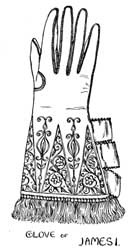 GLOVE OF JAMES I.
GLOVE OF JAMES I.
Some gloves which were the property of James I. are of brown leather lined with white, and the seams are sewn with silk and gold thread. The embroidery is in gold and silver thread on crimson satin, with a lining of red silk. They are finished with gold fringe, and have three loops at the side. A glove of chaste design, worn by Charles I. on the scaffold is made of cream-coloured kid, the gauntlet embroidered with silver and edged with silver fringe. Queen Anne, on the other hand, wore highly-decorated gloves of Suede kid, with raised silken flowers on the gauntlet, and three loops of rose-coloured ribbon, to allow them to be slipped over the hands. They are further enriched with gold lace and embroidery. A yellow Suede Court glove of George IV. gives the impression that the first gentleman of Europe had a fist of tremendous proportions. Her Majesty Queen Victoria generally wears black kid gloves, except for Court functions, when white glacé kid gloves are invariably used.
Her Royal Highness the Princess of Wales has a delicately-formed hand with tapering fingers, and her size is six and a-half. Her Royal Highness adapts her gloves to the occasion and toilette, and is always bien ganté.[Pg 28]
The first Napoleon gave an impetus to this branch of industry by insisting on gentlemen wearing gloves on State occasions and at festive gatherings, and the fashion spread through the countries of Europe with astonishing rapidity.[Pg 29]
"A tasteful slipper is my soul's delight."
—Milman's "Fazio."
A well-shaped foot has been considered from the earliest times one of Nature's kindest gifts, and sober history and fairy lore have combined to give us many interesting particulars respecting this portion of the human anatomy. The similarity of the foot-gear of both sexes makes it impossible to treat the matter separately, and as the subject is practically inexhaustible, I propose only to illustrate the most curious and notable examples.
One of the finest collection of shoes in the world is that at the Cluny Museum, Paris, formed by the eminent French engraver, the late Jules Jacquemart. This was enlarged by the purchase of the collection of Baron Schvitter. The Queen of Italy has also acquired a large number of historical boots and shoes; and to Mr. Joseph Box, another enthusiastic collector, I am indebted for some of the drawings used for illustrating this article.
A quaint story is told in a rare book, entitled "The Delightful, Princely, and Entertaining History of the Gentle Craft of Crispin, the Patron Saint of Shoe Makers, and his Brother Crispianus." According to this authority, they were the two sons of the King of Logia (Kent), and lived in the city of Durovenum, otherwise Canterbury, or the Court of the Kentish men. Having embraced Christianity, during the Roman invasion, they were in considerable danger, and at their mother's instigation, to conceal their identity, adopted humble attire, and devoted themselves to the modest craft of shoemaking, under the auspices of a shoemaker at Faversham, to whom they bound themselves for seven years. This industrious citizen appears to have received the appointment of shoemaker to the Court of Maximinus, whose daughter Ursula fell in love with Crispin. After removing the usual obstacles (which, even in those remote times, seem to have obstructed the paths of those who had fallen under the sway of Cupid), this energetic lady engaged the services of a neighbouring friar, and cut the gordian knot by marrying her faithful adorer.
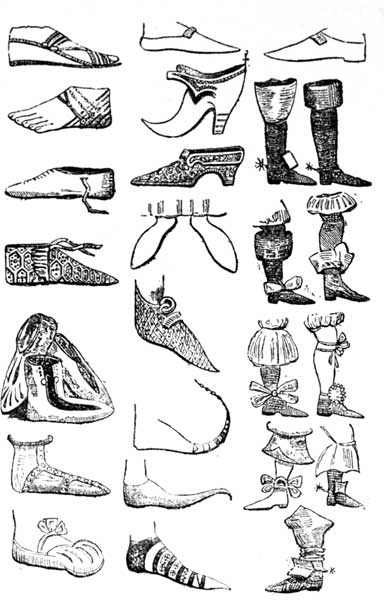 FOOT-GEAR OF DIFFERENT PERIODS.
FOOT-GEAR OF DIFFERENT PERIODS.
When primitive man first conceived the idea of producing some contrivance to defend himself from cold, sharp stones, or the heated sand of the desert, his first effort was to fasten to the bottom of his feet soles of bark, wood, or raw hide, which were followed, in due course, by more elaborately made sandals of tanned leather. These were fastened in various ways, but generally by two leathern straps, one round the instep, while the other passed between the first and second toes. Egyptian sandals were sometimes prolonged to a sharp point, and occasionally were made of papyrus, or some flexible material; but the commoner kinds were, as a rule, of wood or leather. Often they had painted upon them the effigy of the wearer's enemy, who was thus literally trodden underfoot. Owing to their proximity, the habits and customs of the Egyptians and Jews were in many respects similar. The same Hebrew word denotes both a sandal and a shoe; and it has been concluded that shoes were probably confined to the upper classes, while sandals were used by those compelled to work; and slaves went barefoot.
It will be seen from the sketches of Grecian and Roman shoes that they eventually became an elaborate article of dress, bound to the foot and leg with lacings, and ornamented in different ways. The senators had boots of black leather, with a crest of gold or silver on the top of the foot; and soldiers wore iron shoes, heavily spiked, in a similar manner to those now used for cricket, so as to give the wearers a better hold when scaling walls in the attack of fortified places. An iron boot was also used for torturing Christians. As an instance of the luxury so characteristic of the age, it is stated that Roman soldiers often had the spikes on their[Pg 32] shoes made of gold. According to the testimony of Seneca, Julius Cæsar wore shoes of the precious metal, a fashion emulated by Cardinal Wolsey many centuries after; and Severus was fond of covering his with jewels, to attract the attention of the people as he walked through the streets. The Emperor Aurelian forbade men to wear red, yellow, white, or green shoes, reserving these colours for women; and different shapes were prescribed by legal enactments to be worn for the easy distinguishment of various trades and professions. In the reign of Domitian, the stalls of shoemakers in the public streets were so numerous as to necessitate an edict for their removal.
Our own ancestors, the Anglo-Saxons, wore shoes of raw cow-hide, reaching to the ankles; and the hair turned outward. Those used by ecclesiastics were a kind of sandal fastened with bands of leather round the instep. The Norman half-boots had soles of wood, while the uppers were of a more pliable material. Those worn by the Crusaders were of chain, and later of plate armour. Very pointed toes were in fashion during the Middle Ages, and these were carried to such a ridiculous length that the dignitaries of the Church considered it necessary to preach against the practice. However, this did not result in its abolition, for we find the courtiers of the day improved upon the prevailing mode by stuffing their shoes, and twisting them into the shape of a ram's horn; the point of which was attached to the knee by a chain. The common people were permitted by law to wear "the pykes on their shoon" half-a-foot, rich citizens a foot, while nobles and princes had theirs two-and-a-half feet long.
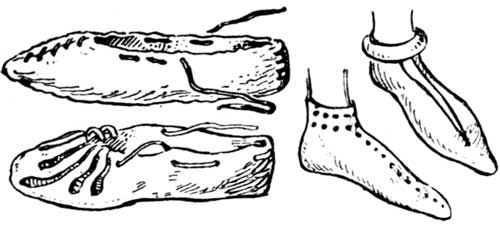 ANGLO-SAXON AND NORMAN SHOES.
ANGLO-SAXON AND NORMAN SHOES.
During the Plantagenet period it was usual to wear two shoes of different colours, and they were often slashed on the upper surface, to show the bright hose beneath. These were superseded by a large, padded shoe, gored over the foot with coloured material, a fashion imported from Italy, and exaggerated as much as the pointed shoe had been. Buskins were high boots, made of splendid tissue, and worn by the nobility and gentry during the Middle Ages, generally on occasions of State. They were also largely adopted by players of tragedy. They covered the knee, and were tied just below. The sock, or low shoe, on the other hand, was the emblem of comedy.
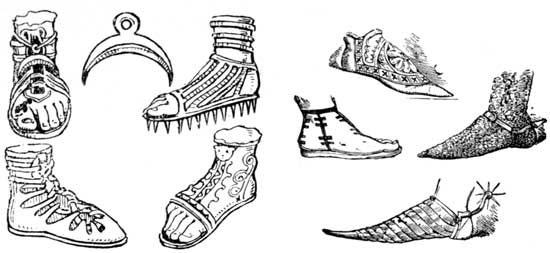 GREEK AND ROMAN SHOES. MEDIÆVAL SHOES.
GREEK AND ROMAN SHOES. MEDIÆVAL SHOES.
One of the greatest follies ever introduced was the chopine, a sort of stilt which increased the height of the wearer. These were first used in Persia, but appeared in Venice about the Sixteenth Century, and their use was[Pg 33] encouraged by jealous husbands in the hope of keeping their wives at home. This desire, however, was not realised, as the ladies went out as usual, and required rather more support than hitherto. Chopines were very ornate, and the length determined the rank of the wearer, the noblest dames having them half-a-yard high. Shakespeare refers to them when he makes Hamlet say:—"Your ladyship is nearer heaven than when I saw you last by the altitude of a chopine." He also alludes to the general use of shoes for the left and right foot, when he speaks of a man:—-
"Standing in slippers which his nimble haste
Had falsely thrust upon contrary feet."
The exercise of the gentle craft of shoemaking was for a long time carried on in monastic institutions, and increased the revenues of the clergy. Richard, the first Abbot of St. Albans, objected to canons and priests of his era associating themselves with tanners and shoemakers, not one of whom, in his opinion, ought to be made a bishop or an abbot. It is said, however, that Pope John, elected in 1316, was the son of a shoemaker at Cahors; and in the description of Absalom, the Parish Clerk, Chaucer tells us, "the upper leathers of his shoes were carved to resemble the windows of St. Paul's Cathedral," which inclines one to believe in their priestly origin.

QUEEN ELIZABETH'S BOOTS. SHOE OF MARY QUEEN OF SCOTS. SHOE WORN BY CHARLES I.
From various sources, we have descriptions of royal shoes. Richard C[oe]ur de Lion had his boots striped with gold; those of his brother John were spotted with gold in circles. Henry III. had his boots chequered with golden lines, and every square enriched with a lion. In the splendid Court of Edward III., the royal shoes were elaborately embroidered. The coronation shoes of Richard III. were covered with crimson tissue cloth of gold. Henry VIII. is described as wearing square-toed shoes, which were slashed with coloured silk, and exposed a portion of the foot. Some worn by his daughter, Queen Elizabeth, of brocaded silk, are remarkably clumsy in appearance, and have lappets which fasten over the instep. They form a striking contrast to[Pg 34] those used by the unfortunate Mary Queen of Scots (now in the possession of Sir James William Drummond), which are of kid, embroidered with coloured silks; the toes are somewhat squarer, but in other respects resemble those in fashion at the present day.
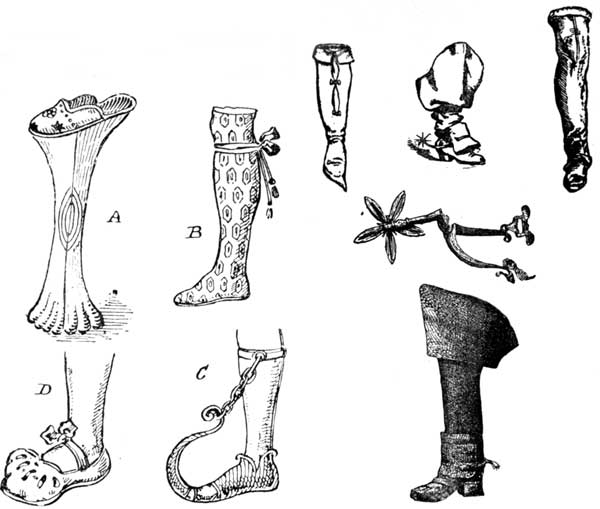
A. CHOPINE; B, BUSKIN; C, PEAKED SHOE; D, TUDOR SHOE. MILITARY BOOTS AND SPURS USED AT THE BATTLE OF NASEBY.
In speaking of curious foot-gear, the under covering of the leg and pedal extremities must be briefly referred to. Ancient works on costume frequently mention hose, socks, and stockings, which were made of woollen cloth, leather, or linen, and held in place by cross-bands of the material twisted to a little below the knee, either in close rolls, like the hay-bands of the modern ostler, or crossing each other sandal-wise, as they are now worn in some districts of Europe, particularly in Russia and Spain. Cloth stockings, embroidered with gold, are among the articles of dress ordered by Henry III. for his sister Isabel; and of a woman[Pg 35] mentioned in the "Canterbury Tales," it is said: "Hire hosen weren of fine scarlet redde, ful streite yteyed (tied), and shoon full moist (supple) and newe."
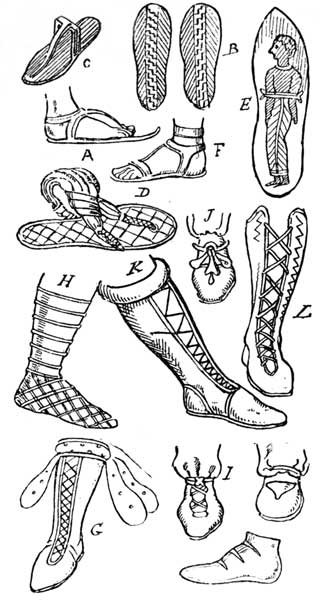 ANCIENT SHOES—A, B, C, D, E, EGYPTIAN; F, PERSIAN; G, H,
GREEK; I, J, K, L, PHRYGIAN AND DACIAN.
ANCIENT SHOES—A, B, C, D, E, EGYPTIAN; F, PERSIAN; G, H,
GREEK; I, J, K, L, PHRYGIAN AND DACIAN.
In the reign of Henry VII. clocks on stockings are discernible; and the Poet Laureate of this king, describing the dress of the hostess of an inn, gives an indication of how boots were cleaned:
"She hobbles as she goes,
With her blanket hose,
Her shoone smeared with tallow."
It is supposed that hose or stockings of silk were unknown in this country before the middle of the 16th century. A pair of Spanish silk hose was presented by Sir Thomas Gresham to Edward VI., his father never having worn any but those made of cloth. In the reign of good Queen Bess, nether socks or stockings were of silk, jarnsey, worsted crewel, or the finest yarn, thread, or cloth, and were of all colours, "cunningly knit and curiously indented in every point, with querks, clocks, open seams, and everything else accordingly." Planché states, in the third year of Elizabeth, Mistress Montague, the Queen's silk-woman, presented Her Majesty with a pair of black silk knit stockings, made in England; and from that time she wore no others, in the laudable desire to encourage their home manufacture by her own example. The Queen's patronage, and the invention, in 1599, of a weaving frame, by William Lee, Master of Arts, and Fellow of St. John's College, Cambridge, gave a great impetus tus to the stocking trade, which has been carried on with considerable success ever since, particularly in the Midland counties of England.
Spurs can be traced back to the Anglo-Saxon period, which is quite far enough for this purpose. They had no rowels, but were made with a simple point like a goad, and were fastened with leathers. Early in the 15th century spurs were screwed on to a steel shoe, instead of being fastened with straps. They were long in the neck, and the spikes of the rowels of formidable dimensions. From a sketch of a spur worn at the Battle of Naseby, in the reign of Charles I., it will be seen that, as progress was made in armour and military gear, considerable attention was paid to this portion of the soldier's outfit; indeed, it was more elaborate in design than is now considered necessary. From a very early period spurs have been used by both sexes.[Pg 36]
A curious custom was in vogue at the beginning of the present century for ladies to make their own indoor shoes. This fashion was inaugurated by Queen Charlotte, who was particularly deft in handling a beautiful set of shoemaker's tools, mounted in silver, with ivory handles. Tradesmen bitterly complained that worktables in boudoirs were strewn with the implements of their craft; but, like many other feminine fads, it soon passed away. About this period clogs were also used. These were made of wood, and served as a protection to shoes out of doors. A similar contrivance, with the addition of an iron ring, leather strap and toe-cap, is still sometimes worn by farm servants, and is called a patten. Another form of clog, consisting of a laced leather boot with wooden sole, is extensively used by the working classes in the North of England, and the sabot, a wooden shoe, is the ordinary foot-gear of peasants on the Continent.
It is well known that Chinese women of high rank deform their feet by compressing them in such a manner that it is afterwards almost impossible to walk; and in Davis' interesting description of the Empire of China, he relates that whenever a judge of unusual integrity resigns his post, the people accompany him from his home to the gates of the city, where his boots are drawn off with great ceremony, and are afterwards preserved in the Hall of Justice.
In Japan a peculiar wooden sandal, having a separate compartment for the great toe, is in common use. Straw slippers are also worn, and a traveller starting on a journey will strap a supply on his back, so that he may have new shoes in case of need. They are lefts and rights, and only cost a halfpenny the pair. Here one never finds those deformities of the feet so common in China, and even in our own country. A graceful carriage depends so much upon the shoes worn. Heavy and stiff ones oblige the wearer to plant the foot solidly at every step. If the toes are very pointed it is at the sacrifice of elasticity, and if the heels are too high the muscles in the ball of the foot are little used.
Orientals indicate reverence by uncovering their feet, and do so on all occasions when Western nations would remove their hats. Their heads, being generally shaven, are always covered, and are surmounted by a head-dress which could not be replaced without considerable trouble; while for the feet they have loose slippers, with a single sole, made of coloured morocco or embroidered silk, which are easily thrown off. Few things inspire them with greater disgust than for anyone to enter their rooms with shoes on. They think such conduct an insult to themselves and a pollution to their apartment; and it is considered the height of irreverence to enter a church, mosque, or a temple without removing them. Even classical heathenism affords instances of this usage. The Roman women were obliged to go barefoot in the Temple of Vesta; the same rule existed in that of Diana, at Crete; and those who prayed in the Temple of Jupiter also followed this custom.
In the East, the public removal of the sandal or shoe, and the giving it to another, accompanied by certain words, signifies a transfer of authority or relinquishing possession. We are told in the case of Ruth and Boaz, when her kinsman gave up his right to marry her, in favour of her second husband, "he drew off his shoe." Among the Bedouins, when a man permits his cousin to marry another, or divorces his runaway spouse, he generally says, "She was my slipper; I have cast her off." Again, when shoes are left at the door of an apartment, they denote that the master or mistress is engaged, and even a husband does not venture into a wife's room while he sees the slippers on the threshold. The idea is not altogether unknown among ourselves, as it is expressed in the homely proverb, "to stand in another man's shoes;" or when we speak of coming into a future inheritance as stepping into a "dead man's shoe." Also in flinging the slipper after a departing bride, signifying that the father transfers his authority to the husband.[Pg 37]
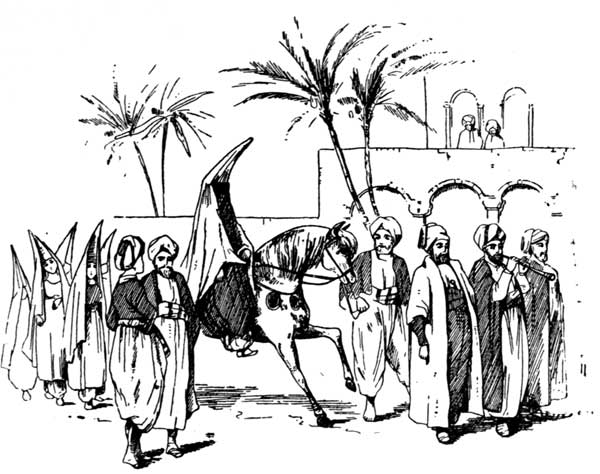 MARRIAGE PROCESSION OF A BRIDE IN LEBANON.
MARRIAGE PROCESSION OF A BRIDE IN LEBANON.
Certain curious customs have been associated with the Ordinance of Marriage from a very early period, and among others may be mentioned the union of near relations in barbaric or semi-barbaric tribes; the providing of husbands and wives for a family according to seniority (so that the younger members had to possess their souls in patience till the elder ones were disposed of); the paying of an equivalent for the bride's services to her father in money or kind; and festivities often lasting over several days to celebrate the nuptials. The Rabbins acquaint us with the fact that seven days' feasting was an indispensable obligation on all married men, and that the bride was not consigned to her husband until after the days of feasting had expired. They were generally spent in the house of the woman's father, after which she was conducted in great state to her husband's home. When the bride was a widow, the festivities only lasted for three days. Customs in the East are perpetuated from one generation to another, and we now find among the inhabitants of the Orient the same mode of life as was adopted by the patriarchs of old. The description of the wooing of Isaac and Rebekah, for example, so graphically told in Genesis, differs in few respects from that of a young couple of the same rank in the present day. Handsome presents, consisting of jewels, apparel, &c., are presented to the woman and her family, and form part of her dower in case of divorce. Rich shawls, fine dresses, personal ornaments, money, and a complete outfit of domestic utensils are always included in such a gift. Among some of the Arab tribes the dower received on such occasions, and called the "five articles," consists of a carpet, a silver nose ring, a silver neck chain, silver bracelets, and a camel bag. Matrimonial overtures are generally made by the parents of the contracting parties in Persia, but after all has been concluded, the bride-elect has nominally the power, though it is seldom exercised, of expressing her dissent before the connection receives its final sanction. Among many Bedouin tribes the woman is not suffered to know until the betrothing ceremonies announce it to her who is to be her husband, and then it is too late to negative the contract, but she is permitted to withdraw from her husband's tent the day after her[Pg 40] marriage, and to return to her father; in which case she is formally divorced, and is henceforward regarded as a widow. On the value of her ornaments the Eastern bride bases her claim to consideration; and though the Arab, as a rule, cares little for his own dress, he decks his wife as richly as possible, that honour may be reflected upon himself and his circumstances. The leg ornaments and bracelets are often enormously thick, and have no fastenings, but open and compress by their own elasticity. It is not unusual to wear several on the same arm, reaching to the elbow. They form a woman's sole wealth, and are not treasured up for special occasions, as is usual among Western nations, but are used as part of of the daily costume. Various materials are employed in their manufacture; gold is necessarily rare, silver less so, while others are composed of amber, coral, mother-of-pearl, and beads.
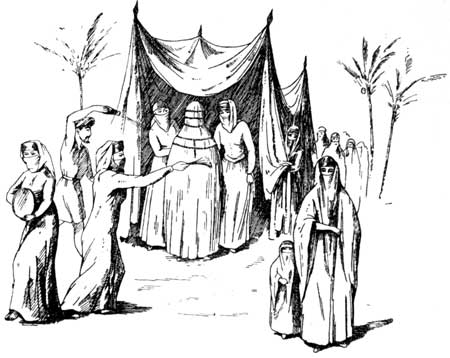 FESTIVITIES AT AN EASTERN MARRIAGE.
FESTIVITIES AT AN EASTERN MARRIAGE.
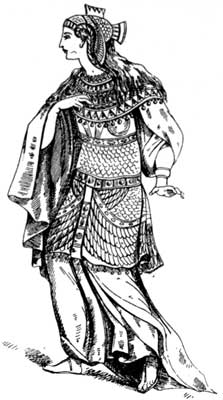 ANCIENT EGYPTIAN BRIDAL COSTUME.
ANCIENT EGYPTIAN BRIDAL COSTUME.
We are told, when Rebekah approached her future home and saw a man walking in the distance, she evinced a curiosity, natural under the circumstances, and inquired about him; and on discovering that it was Isaac, "she took a veil and covered herself." It is still almost universal in the East for a woman, whose face is not concealed on other occasions, to envelop her head and body in an ample veil before she is conducted to her husband, and it is considered an indispensable part of the bridal costume. The details of the home coming are modified by the local usages and religions of the different countries. In Syria, Persia, and India, the bridegroom, in person, brings home the bride; in some other countries this duty devolves on a near relative, and he remains at home to receive the lady on her arrival. From various sources, but particularly from indications in Scripture, we may gather that the Jews employed either of these methods, according to circumstances. Again, in Egypt the bridegroom goes to the Mosque when his bride is expected, and returns home in procession after she has arrived. In Western Asia the procession usually walks, if the[Pg 41] bride's future house is at no great distance in the same town. In such cases she is often partially covered by a canopy, and in Central and Eastern Asia it is the rule for her to be mounted on a mare, mule, ass, or camel, unless she is carried in a palanquin. Much, of course, depends on the social position of those married. Music attends such processions, and often dancing; the Jews certainly had the former, and some think the latter also, at least, in the time of our Saviour.
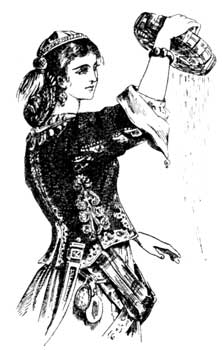 A GREEK BRIDESMAID.
A GREEK BRIDESMAID.
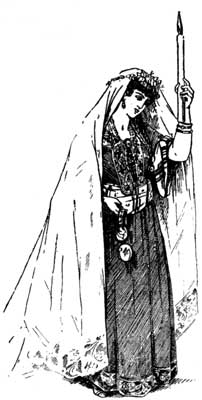 MODERN GREEK BRIDAL COSTUME.
MODERN GREEK BRIDAL COSTUME.
In Halhed's translation of the Gentoo Laws, and in Mr. Roberts's "Oriental Illustrations," reference is made to the custom of marrying the elder sister first, and the same usage is observed with regard to the brothers. When, in India, the elder daughter happens to be blind, deaf, dumb, or deformed, this formality is dispensed with; and there have been cases when a man, wishing to obtain a younger daughter, has used every means in his power to promote the settlement of his future sister-in-law, so as to forward his own nuptials. Fathers, too, will sometimes exert their powers to compass the marriage of the elder daughter, when a very advantageous offer is made for the younger one.
It is generally believed that Psalm xlv., commonly known as "The Song of Loves," was composed on the occasion of Solomon's marriage—probably to Pharaoh's daughter; and here we find the Egyptian bride's dress described as "all glorious within and wrought of gold, a raiment of needlework." Both expressions refer to the same dress, and imply that the garment was embroidered with figures worked with threads of gold. The Egyptians were famous for their embroideries, and some mummies have been found wrapped up in clothing curiously ornamented with gold lace. At the present day, both in Egypt and Western Asia, it is usual for ladies of the highest rank to employ much of their time in working with the needle linen and cotton tissues in gold and silver thread and silk of different colours.
The use of nuptial crowns is of great antiquity. Among the Greeks and Romans they wore chaplets of flowers and leaves, and the modern Greeks retain this custom, employing such chaplets, decorated with ribbons and lace. Modern Jews do not use crowns in their marriage ceremonies, and they inform us that they have been discontinued since the last siege of Jerusalem by the[Pg 42] Romans. The information which Gemara gives on this subject is briefly that the crown of the bridegroom was of gold and silver, or else a chaplet of roses, myrtle, or olives, and that the bride's crown was of the precious metals. There is also some mention of a crown made of salt and sulphur, worn by the bridegroom, the salt transparent as crystal, the figures being represented thereon in sulphur. Crowns play an important part in the nuptial ceremonies of the Greek Church; they are also still used by Scandinavian brides.
The ring in former days did not occupy the prominent position it does now, but was given, with other presents, to mark the completion of the contract. Its form is a symbol of eternity, and signifies the intention of both parties to keep the solemn covenant of which it is a pledge, or, as the Saxons called it, a "wed," from which we derive the term wedding. The Jews have a law which proclaims that the nuptial ring shall be of certain value, and must not be obtained by credit or gift. Formerly they were of large size and elaborate workmanship, but now the ordinary plain gold hoop is used.
 A, JEWISH WEDDING RING, GERMAN, 17TH CENTURY; B, MODERN
ITALIAN; C, ITALIAN, 14TH CENTURY; D, VENETIAN, 16TH CENTURY; E,
ENGLISH, 1706; F, ENGLISH BRONZE BETROTHAL RING, 17TH CENTURY.
A, JEWISH WEDDING RING, GERMAN, 17TH CENTURY; B, MODERN
ITALIAN; C, ITALIAN, 14TH CENTURY; D, VENETIAN, 16TH CENTURY; E,
ENGLISH, 1706; F, ENGLISH BRONZE BETROTHAL RING, 17TH CENTURY.
A wedding ring of the Shakespearian era has a portrait of Lucretia holding the dagger, the reverse side of the circle being formed by two clasped hands. This is a very common shape, and is shown in the illustration of the English wedding-ring E, dated 1706, where white enamel fingers support a rose diamond. The modern Italian peasant wedding-ring B is of gold in raised bosses, while C is of silver; F, bearing initials on vezet, is of bronze. A is a handsome Jewish wedding-ring, bearing the ark, and D also has a Hebrew inscription.
The gimmal betrothal ring was formerly a favourite pattern, and consisted of three circlets attached to a spring or pivot, and could be closed so as to appear like one solid ring. It was customary to break these asunder at the betrothal, the man and woman taking the upper and lower ones, and the witness the intermediate ring. When the marriage took place these were joined together and used at the ceremony. During the sixteenth and seventeenth centuries it was a common practice to engrave these emblems of affection with some appropriate motto. It was from Pagan Rome that European nations derive the wedding-ring, as they were used in their betrothals long before there is any trace of them elsewhere.
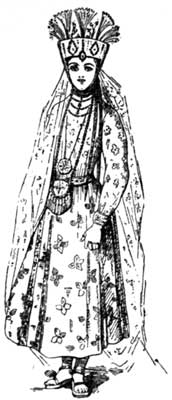 AN EASTERN BRIDE.
AN EASTERN BRIDE.
In describing the bridal costumes of[Pg 43] different nations, it should be distinctly borne in mind that a large majority of the upper classes wear on such occasions the traditional white satin and orange blossoms with which we are all familiar. Many, however, prefer the picturesque national costume associated with the land of their birth, and it has been my principal object, in selecting the illustrations, to make them as typical as possible.
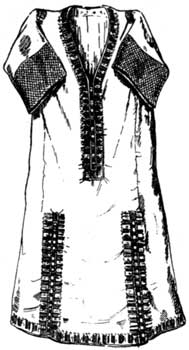 GARMENT FORMERLY WORN BY GREEK BRIDES.
GARMENT FORMERLY WORN BY GREEK BRIDES.The Greek marriage service is full of symbol, and the sketch gives a good idea of the bridal costume. The bridesmaid is attired in a gold embroidered jacket, a skirt of brilliant colouring, and the crimson fez—the usual head-gear of a Greek maiden. She is depicted scattering corn, an ancient rite always performed at the conclusion of the ceremony. As she gracefully sways backwards and forwards, to the accompaniment of the jingling coins, which do double service as dowry and trimming, it is a pose and dress at once graceful and free. Formerly a wedding garment was often passed down from mother to daughter, and such an example is given in the soft yellow silk robe, lined with white and enriched with elaborate embroidery. Tiny stars in delicate shades of red, blue, and green, divided by black lines form the design and proclaim the industry and skill of the worker. These robes, however, have not been used in Greece since the beginning of the seventeenth century.
In Japan, the beautiful land of the lily and chrysanthemum, the bride usually takes little more to her husband's home than her trousseau, which is ample enough, as a rule, to satisfy even a woman's passion for dress. The nuptials take place in the evening, and the bride is garbed in virgin white robes, figured with a lozenge design. These garments are the gift of the bridegroom, and in them she passes from the home of her girlhood to that of her husband. The household gods of both families are assembled before an altar decked with flowers and covered with offerings. Near stands a large table, with a dwarf cedar; it also holds the Japanese Adam and Eve, and the mystic turtle and stork. The two special attendants of bride and bridegroom are called butterflies, and in their dress and colouring rival these beautiful insects, which in this country are the symbol of conjugal felicity. The most solemn part of the marriage ceremony is the scene of the two-mouthed vase. At a signal, one butterfly fills the vase, and the other offers it to the kneeling couple, the husband drinking first, and afterwards the wife. This draught signifies that henceforward they are to partake equally of the bitters and sweets of the coming years. Rice is thrown from either side, so as to mingle, and the wicks of two candles are placed together, to symbolize the joining of body and soul.
The marriage processions of other Oriental nations have already been referred to, and in India it is customary to perform the ceremony under a species of canopy richly ornamented and lighted by lamps. The bride wears, in addition to the native costume, a curious veil composed of strings of gold beads and tassels. In Hindu marriages the sacred fire or oman (which is constantly renewed by throwing upon it scented oils, sandalwood, incense, and other aromatic perfumes) is a prominent feature, and the union of a couple is consecrated by sprinkling a handful of saffron, mixed with rice flour, on their shoulders. Finally, the husband presents his wife with a little golden image called talee, a substitute for the wedding ring, and worn by Indian women as their symbol of matrimony.
A missionary thus describes a Buddhist marriage:—"The bride, loaded with jewellery, accompanied by women richly attired, entered the room, and sat down with the bridegroom on the floor. A number of[Pg 44] candles were then lighted, and the company saluted and congratulated the happy couple, and expressed their kind wishes by blowing smoke towards them, while a band of string instruments discoursed sweet music. Two cushions were placed before the bridegroom, on which a sword was laid, and food was also near them. Next the hands of each were bound together, then the two to each other with silken threads. This act was performed by the nearest relative present, and completed the ceremony." Brief, indeed, are the forms of marriage indulged in by the people of Borneo. Each of the contracting parties chews a betel nut; an elderly woman mutters some sort of incantation, and brings the heads of bride and bridegroom in close contact, after which they are declared man and wife, and are no longer regarded as twain, but one flesh. The Cherokee form of marriage is perhaps the most simple. The two join hands over a running stream, emblematic of the wish that their future lives, hopes, and aspirations, should flow on in the same channel. A peculiar custom of the Lascars is the putting of a ring on the great toe when they marry. Mrs. Bishop, who has explored Tibet and studied the habits and customs of the people, informs us that polyandry is favoured by the women of that country. The heir of the land and eldest son appears to be the only member of the family who can contract a marriage in the legal sense as we understand it, but all his brothers are accepted by the wife as inferior or subordinate husbands. By this means they are kept well under the control of the superior husband, whom they regard as the "Big Father," and, as a matter of form, any children who may be born are accepted by him.
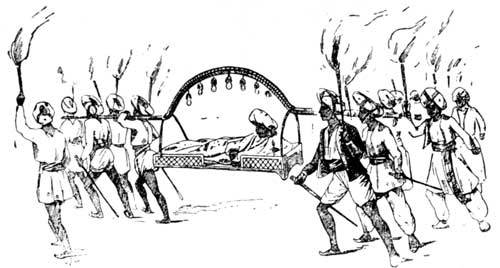 HINDU BRIDEGROOM'S PROCESSION.
HINDU BRIDEGROOM'S PROCESSION.
Thus the whole family are attached to the soil, and seem to work in concord, and the women have the satisfaction of knowing that in the average course of Nature they can never become widows, and that there will always be someone to work for them and their offspring. "It is the custom for the men and women of a village to assemble when a bride enters her home with her husbands, and for each of them to present her with three rupees. The Tibetan wife, far from spending these gifts on personal adornment, looks ahead, contemplating possible contingencies, and immediately hires a field, the produce of which is her own, and accumulates from year to year, so that she may not be portionless should she desire a divorce."
The African tribes, of course, differ materially in their marriage customs, but some form of exchange for the services of the woman are insisted on, and often take the shape of a present of cattle to the bride's father. On the West Coast, in the neigh[Pg 45]bourhood of Gaboon, where slavedom is recognised, there is an understanding that a wife may be purchased for a slave bundle, valued at about £6 in English money, and there appears to be no sliding scale as to youth, beauty, form, or degree. A bundle contains specimens of every article sold by a general storekeeper. The most important features of a slave bundle are a Neptune, or brass pan used for making salt, which is a current article of commerce, and a piece of native cloth, manufactured by these people for dress purposes, from a species of palm which grows on the river banks in great luxuriance. Both sexes anoint themselves with palm oil and other greasy substances, and no greater compliment can be paid to an African belle than to say she looks "fat and shining."
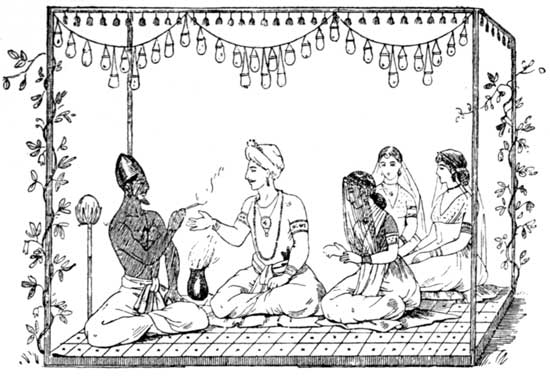 HINDU MARRIAGE CEREMONY.
HINDU MARRIAGE CEREMONY.
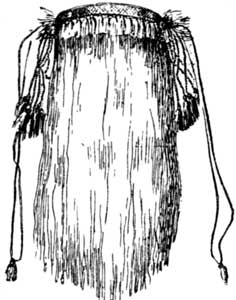 VEIL OF HINDU BRIDE.
VEIL OF HINDU BRIDE.
Mr. Hutchinson, in his interesting work, "Ten Years in Æthiopia," gives a quaint and amusing account of the toilet of a Fernandian bridegroom: "Outside a small hut, belonging to the mother of the bride expectant, I soon discovered the happy bridegroom undergoing his toilet at the hands of his future wife's sister. A profusion of Tshibbu strings being fastened round his body, as well as his legs and arms, the anointing lady, having a short black pipe in her mouth, proceeded to rub him over with Tola pomade. He seemed not altogether joyous at the anticipation of his approaching happiness, but turned a sulky gaze now and then on a piece of yam which he held in his hand, and which had a parrot's red feather fixed on its convex side. This was called 'Ntshoba,' and is regarded as a protection against evil influences on the important day. The bride was borne down by the weight of rings and wreaths and girdles of Tshibbu. Tola pomatum gave her the appearance of an exhumed mummy, save her face, which was all white; not from excess of modesty, for the negro race are reported to blush blue, but from being smeared over with a white paste, the emblem of purity." What a hideous substitute for the classical wreath of orange blossoms, and what a contrast must be offered when the cosmetic peels off and displays the dusky skin upon which it is laid!
According to Russian law, no man can[Pg 46] marry before he is eighteen years of age, or a woman before she is sixteen; nor after he is eighty, and she is sixty. Priests are permitted to marry once. Secret marriages without witnesses are regarded as invalid, and both bride and bridegroom must be baptized persons. If a Russian takes a foreigner for a wife, she must bind herself in writing to bring up any children she may have in the Greco-Russian faith. According to an ancient custom the bridegroom presents his bride with the costume and jewellery worn at the marriage. The dowry comes from her family, and consists of a complete wardrobe, silver, linen, and household furniture of all kinds. The hair of an unmarried woman of the peasant class in Russia is dressed in a single plait hanging loose upon the shoulders, and tied with ribbon. After marriage it is arranged in two braids coiled round the head, covered with a cap tied behind, or with a cotton or silk handkerchief and a little lappet of linen rests on the forehead, and is considered an inevitable symbol of marriage. Marriages are performed after banns, and much of the finery used by the lower classes is hired for the occasion; and the crowns used in the Russian ceremony are generally the property of the Church. Formerly they were worn for a week, but this practice has been discontinued.
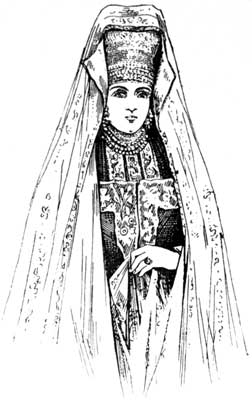 A RUSSIAN BRIDE.
A RUSSIAN BRIDE.
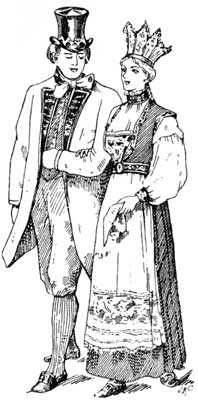 NORWEGIAN PEASANT BRIDE AND BRIDEGROOM.
NORWEGIAN PEASANT BRIDE AND BRIDEGROOM.
There are three distinct periods in the life of a Norwegian woman, and each one has marked characteristics, particularly as regards dress. During girlhood, up to the time of confirmation, a solemn occasion for which there is much preparatory training, girls do not usually go from home to work, or earn their own living. Among the poorer classes this ceremony takes place when they are about fifteen. Their petticoats are short and their hair is arranged in two long plaits. After confirmation they are supposed to[Pg 47] regard life from its more serious aspect, and to engage themselves with various duties, according to their station. The third stage, of course, is married life, and it should be stated that neither men nor women can enter upon the holy contract unless they can bring proof of their confirmation, and can show ample evidence of sufficient means to provide for a household. The marriage is preceded by a betrothal ceremony, when the young couple go to the church, accompanied by their friends, and exchange rings of plain gold and presents of jewellery and apparel, which must be worn on the wedding day. At her marriage the peasant bride wears the crown. It has a rim of brass to fit the head, and the upper portion is of silver and gold, sometimes embellished with precious stones. Such crowns are generally heirlooms, and it is not uncommon for all the brides of one family for centuries to wear the same adornment for the head. A very usual dress on such an occasion is a plain skirt of some woollen material, with a bodice and full sleeves of snowy linen, a corselet of red and green, ornamented with bands and buckles, and a white apron trimmed with embroidery. A silver-gilt breast ornament is worn by Swedish brides. The band is wrought with bosses, and depending from it are small beaten discs, and a medallion bearing the sacred initials I.H.S. The bridegroom's hat in the illustration was probably an heirloom too, from its shape and fashion. He wears a red waistcoat cut short and fastened with brass buttons, and a loose cloth coat ornamented with embroidered revers. The black small clothes show to advantage a well-shaped leg, and on the feet are low shoes. Usually the festivities in connection with a peasant wedding in Norway are kept up for three days, and during the time there is much feasting and merrymaking among the friends of bride and bridegroom.
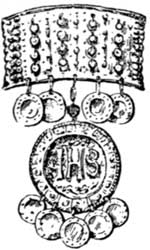 ORNAMENT WORN BY SWEDISH PEASANT BRIDE.
ORNAMENT WORN BY SWEDISH PEASANT BRIDE.
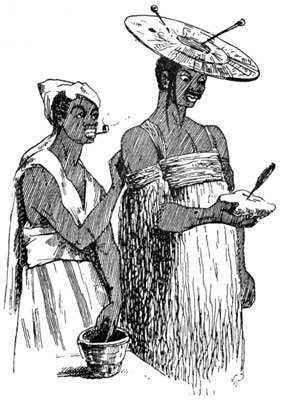 A BRIDEGROOM'S TOILET AT FERNANDO PO.
A BRIDEGROOM'S TOILET AT FERNANDO PO.
Gipsies are, as a rule, married at a very early age. A girl is generally betrothed at fourteen, and becomes a wife two years later. The marriage ceremony is performed by a priest wearing a ram's horn as a sign of office, and, as becomes a nomadic race, the four elements—fire, air, earth, and water—take a prominent position. The horn is the symbol of authority, and is often made use of in Scripture. So much were rams' horns esteemed by the Israelites that their priests and Levites used them as trumpets in the taking of Jericho; and modern Jews when they confess their sins announce the ceremony by blowing a ram's horn. In ancient Egypt and other parts of Africa, Jupiter Ammon was worshipped under the figure of a ram, and to this deity one of these animals was sacrificed annually. It seems to have been an emblem of power from the remotest ages. It would therefore appear that the[Pg 48] practice of the gipsy priest wearing a ram's horn suspended from a string round his neck at a marriage is derived from the highest antiquity, and undoubtedly points to the Oriental origin of the gipsy race.
Various expedients have been resorted to by different rulers of sparsely populated kingdoms to encourage men to enter the married state. In ancient Rome the law forbade that a bachelor should inherit any legacy whatever, and in Sparta, under the rule of Lycurgus, they were not permitted to have a part in the government, nor might they occupy any civil or military post. They were excluded from participation in public festivals, except on certain fixed occasions, and then the women had the right to lead them to the altars, where they were beaten with rods to the sound of scornful songs. As late as the reign of William and Mary, widowers were taxed in England at the following rates:—Dukes, £12 10s.; lower peers a smaller sum, and commoners one shilling each, if they elected to remain in a state of single blessedness. Widows also, especially those of high degree and fortune, were encouraged to dip again in the matrimonial lottery, and children were betrothed at a very tender age.
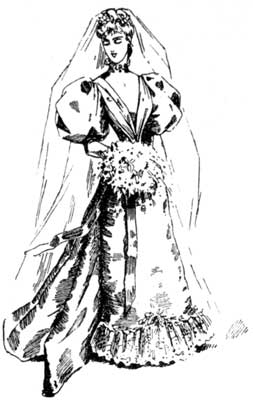 AN ENGLISH BRIDE.
AN ENGLISH BRIDE.
Bridesmaids in Anglo-Saxon times attended on the bride, and performed specified duties, particularly in the festivities which usually followed on such occasions. Even during the earlier portion of the present century it was a common custom for one to accompany the bridal couple on their honeymoon; and it was also her duty to prepare and present the "benediction posset," which is referred to by Herrick in "Hesperides:"—
"A short sweet prayer shall be said,
And now the posset shall be made
With cream of lilies not of kine
And maiden blush for spiced wine."
The fashion of brides wearing spotless white is a comparatively modern one. From accounts of bridal gowns in bygone times, we find rich brocades, golden tissues, and coloured silks were employed for this purpose; and at the present day white is considered only appropriate to the virgin, and is absolutely dispensed with by those women who have been married before.
Of modern marriage customs in England there is no occasion to speak, for what woman is there among us who has not made an exhaustive and complete study of this vital matter? It may, however, comfort those who are beginning to wonder if marriage and giving in marriage is going out of fashion, to know that during the first quarter of 1894, 95,366 persons were joined together in the British Islands, an increase of 18 per cent. over the first three months of the previous year, 1893 and 9 per cent. over the mean rate for the same quarter for the preceding ten years. Figures are incontrovertible facts, so our ears need no longer be assailed by the bitter cry of
"Darkest Spinsterdom."
[Pg 49]
"The air is full of farewells to the dying
And mourning for the dead."—Longfellow.
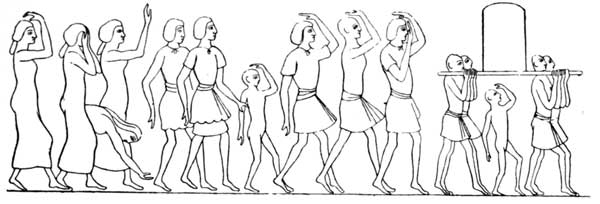 ANCIENT JEWISH FUNERAL PROCESSION.
ANCIENT JEWISH FUNERAL PROCESSION.
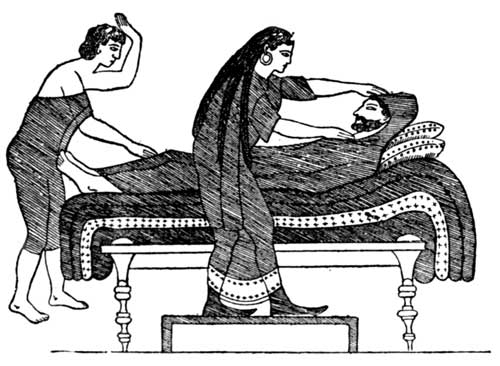 LAYING OUT AND MOURNING THE DEAD.
LAYING OUT AND MOURNING THE DEAD.
The signs of mourning in ancient times were by no means confined to the apparel. Fasting, laceration of the flesh, throwing dust on the head, and shaving the hair, were outward and visible signs of grief, accompanied by piercing cries of the most heartrending description. It was also customary to abstain from ornaments, to rend the clothing, and to put on filthy garments of sackcloth. This fabric was, and is still in the East, made of hair, which has an irritating effect upon the skin, and was for this purpose adopted as a penitential dress by the early Roman Church. The covering of the head was another manifestation of sorrow—a practice indicated by the hoods worn by female mourners, and the flowing hat-bands for men, so common at funerals a few years ago. In "A History of Mourning," by Richard Davey, from which many interesting facts on this subject may be gathered, we learn that the Egyptians, over three thousand years ago, selected yellow as the colour for mourning garments. The Greeks chose black as the most appropriate—a fashion followed by the Romans. The women of Rome had robes of black cloth, with veils of the same shade; but by a wise dispensation, young children were not compelled to adopt the symbols of woe. A year was the usual period for mourning a husband, wife, father, mother, sister, or brother; but relations who had been outlawed, imprisoned, or bankrupt, were not accorded this mark of respect. Numa published certain laws for the guidance of mourners, including one forbidding women[Pg 52] to scratch their faces, or to make an exceptional display of grief at funerals. The Emperor Justinian (A.D. 537) also turned his attention to this subject, and regulated the expenses at funeral ceremonies, so as to secure those who remained from the double calamity of losing their friends and, at the same time, incurring heavy pecuniary liabilities on their account. Provision was made for burying each person free of cost, and for protecting the survivors from various extortions. Funds were appropriated for the purpose of interments, which were conducted by those appointed for the purpose. All persons were to be buried in the same manner; though those who desired to do so could, at their own cost, indulge in certain display, but this additional expense was limited. On state occasions, as, for example, on the death of an Emperor or a great defeat, the whole nation assumed the mourning garb. The defeat of Cannæ, the conspiracy of Catalina, and the death of Julius Cæsar, were all considered of sufficient importance for the observance of this custom. Private mourning could be broken among the Romans by certain domestic events, as the birth of a son or daughter, the marriage of a child, or the return of a prisoner taken in war. Both sexes were expected to abstain from going to public ceremonies and places of amusement; and women were not allowed to marry till a year had elapsed from the husband's death, without the special permission of the Emperor. History, however, does not record that their lords and masters applied this rule to their own conduct.
 THE MODE OF ENFOLDING THE DEAD.
THE MODE OF ENFOLDING THE DEAD.
The Greeks buried their dead before sunrise, so as to avoid ostentation. Mourning women took part in the procession, and accompanied the chief female mourner in her visits to the grave, on the seven days following interment. This custom, which was derived from the East, was a usual feature in Jewish, Roman, and Egyptian, as well as in Greek funerals.
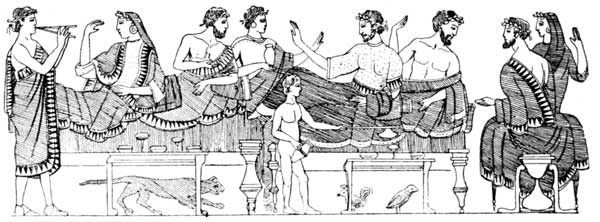 THE CUP OF CONSOLATION.
THE CUP OF CONSOLATION.
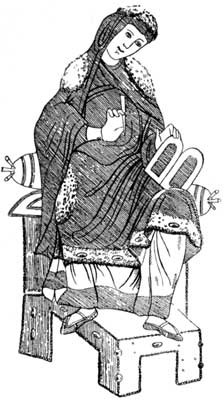 AN ANGLO-SAXON WIDOW.
AN ANGLO-SAXON WIDOW.
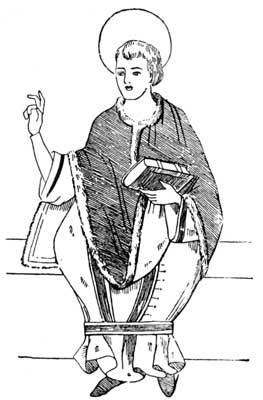 PRIEST OF THE 10TH CENTURY, WEARING A BLACK DALMATIC
EDGED WITH FUR, READY TO SAY REQUIEM MASS.
PRIEST OF THE 10TH CENTURY, WEARING A BLACK DALMATIC
EDGED WITH FUR, READY TO SAY REQUIEM MASS.
The funeral feast was a common practice among the classical ancients, and was kept up to a comparatively recent period, in various European countries. The Cup of Consolation consisted of light refreshments prepared and sent in by the friends of mourners, who were not supposed to busy themselves with domestic affairs at such a time. The illustration gives a good idea of the mourning habit adopted by the immediate family of the deceased. Caves were used for the disposal of the dead, as well as elaborately constructed sepulchres, of which many remain to this[Pg 53] day. Earth burial was in favour with some nations, but in time of war or pestilence cremation was resorted to. The practice of embalming we owe to the Egyptians, who carried it to a great state of perfection. One of the earliest embalmments on record is that of Joseph, whose body accompanied the Israelites on their journey through the Wilderness. He was placed in a coffin, a distinction in the East only accorded to those of the highest rank, the usual mode being to simply swathe the corpse closely in wrappers and bandages, thus retaining the shape of the human form. The Jews largely used spices and perfumes, which were employed both for anointing and for wrapping up the body—a very necessary precaution in hot climates. The Egyptians, on the death of a relative or sacred animal (the cat, for instance), attired themselves in yellow garments and shaved off their eyebrows. Their funeral processions were magnificent. When a king quitted this mortal sphere, the temples were closed for seventy-two days, and there were no sacrifices, solemnities, or feasts. Companies of two or three hundred men and women, in mean attire paraded the streets, singing plaintive songs and reciting the virtues of him they had lost. They ate no meat, or food dressed by fire, and omitted their customary baths and anointings. Every one mourned as for the death of a favourite child, and spent the day in lamentations. The Pyramids, those wonderful monuments to Egyptian monarchs, are memorials of the reverence and industry of the nation, whose high state of civilization is attested to by their works.
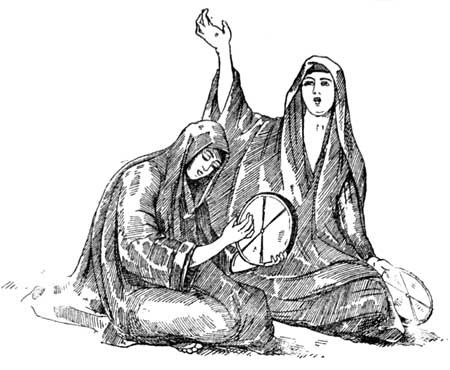 HIRED MOURNERS.
HIRED MOURNERS.
Burial clubs were common among the Anglo-Saxons, and heavy fines were inflicted on those who did not attend the funeral of a member. The corpse was placed on a bier, and on the body was laid the book of the[Pg 54] Gospels, a code of belief and a cross as a symbol of hope. A silken or linen pall was used, according to the rank of the dead person. The clergy bore lighted tapers and chanted the psalter, the mass was performed, and a liberal offering made to the poor.
From a 9th century MS. in the National Library, Paris, is given a sketch which clearly defines the mourning habit of that period. The gown is evidently of black woollen cloth, trimmed with black and white fur; and a gauze veil of the same sombre tint envelops the head. From the same source a drawing of an Anglo-Saxon priest is given, on account of his wearing a black dalmatic, edged with fur, a vestment only adopted when a requiem mass was performed.
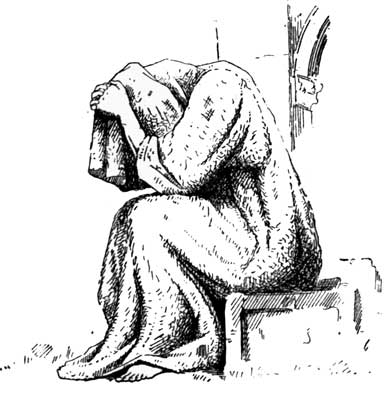 MOURNING IN SACKCLOTH
MOURNING IN SACKCLOTH
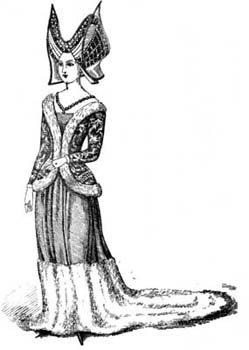 WIDOW'S DRESS OF QUEEN KATHERINE DE VALOIS, IN THE YEAR
1422
WIDOW'S DRESS OF QUEEN KATHERINE DE VALOIS, IN THE YEAR
1422
In the Middle Ages black was used for mourning as a rule, though purple and brown were occasionally substituted. Chaucer, in "The Knight's Tale," speaks of "clothes black all dropped with tears," and, again, of "widdowes habit of samite brown." In many cases, on the death of her husband, the wife retired for a year to a convent, when she assumed the nun's dress, of which the widow's weeds of the present day are a symbol. The mourning adopted by Katherine of Valois, wife of Henry V., the hero of Agincourt, who died at Vincennes in 1422, may be regarded as the typical widow's dress of that period. It consisted of a black brocade cote hardi, edged with white fur, and further embellished with black glass beads, which were also used[Pg 55] for ornamenting the winged head dress. Her black woollen gown has a deep bordering of white fur. Some mourning habits of this period are represented in a splendid manuscript "Liber Regalis," still preserved in Westminster Abbey. They are composed of black fabrics in the prevailing fashion, and are furred with ermine. Froissart relates that the Earl of Foix, on hearing of the death of his son, Gaston, sent for his barber, and was close shaved, and clothed himself and his household in black. At the funeral of the Earl of Flanders, all the nobles and others present were attired in black gowns; and on the death of John, King of France, the King of Cyprus clothed himself in black mourning.
 COSTUMES WORN BY KING PHILIP II. OF SPAIN AND HIS
ATTENDANTS AT THE FUNERAL PROCESSION OF HIS FATHER.
COSTUMES WORN BY KING PHILIP II. OF SPAIN AND HIS
ATTENDANTS AT THE FUNERAL PROCESSION OF HIS FATHER.
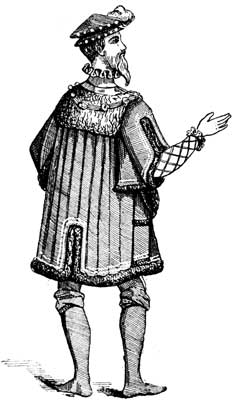 GENTLEMAN'S MOURNING—TIME OF HENRY VII.
GENTLEMAN'S MOURNING—TIME OF HENRY VII.
At the end of the fifteenth century, it was considered necessary in England to pass sumptuary mourning laws, owing to the extravagance of the nobility in the superfluous usage of cloth and other items at funerals. Habits and liveries were limited to certain quantities. Planché tells us dukes and marquises were allowed sixteen yards for their gowns, sloppes (or mourning cassocks) and mantles; an earl, fourteen; a viscount, twelve; a baron, eight; a knight, six; and all inferior persons, two yards only; but an archbishop had the same privilege as a duke. Hoods were only permitted to those above the degree of esquire of the king's household.
Margaret, Countess of Richmond, the mother of King Henry VII., issued, in the eighth year of his reign, an ordinance for "the reformation of apparell for great estates of women in the tyme of mourninge." "They shall have their surcottes with a trayne before and another behynde, and their mantles with traynes. The queen is to wear a surcotte, with the traynes as aforesaid, and playne hoode, and a tippet at the hoode lying a good length upon the trayne of the mantell, being in breadth a nayle and an inche. After the first quarter of a year, the hood to be lined with black satin, or furred with[Pg 56] ermine; and all ladies down to the degree of a baroness, are to wear similar mourninge, and to be barbed at the chin." The surcotte, with trayne, hood, barbe, and tippet, are visible in the sketch of a lady of the sixteenth century, taken from Pietro Vercellio's famous work on costume. The gentleman's mourning of black cloth and fur, is reproduced from a contemporary MS.
Among the obsolete funeral customs, may be mentioned the Death Crier, the lying-in-state of all classes, and the waxen effigies of those of royal rank. Before newspapers published obituary notices, it was customary for the Death Crier, armed with a bell and attired in a black livery, painted or embroidered with skulls and cross-bones, to announce to the townspeople, and inhabitants of surrounding villages, that another had gone over to the majority. This functionary was in the employ of the Corporation, or civil authorities, and on the death of a member of the Royal Family, he was usually accompanied by the Guild of Holy Souls, who walked in procession, bearing lighted tapers and other religious emblems. Lying-in-state usually lasted for three days, by which time the arrangements for a simple interment were completed, and the body was placed reverently in the ground. The obsequies of kings and queens, however, were carried over a protracted period, consequently a waxen figure was prepared, which was dressed in regal robes, and substituted for the body as soon as decomposition set in. This fashion was in vogue till the time of William and Mary, and in Westminster Abbey there is a collection of waxen effigies, which may be viewed by permission of the Dean. As likenesses they are interesting, and they are also useful as costume studies.
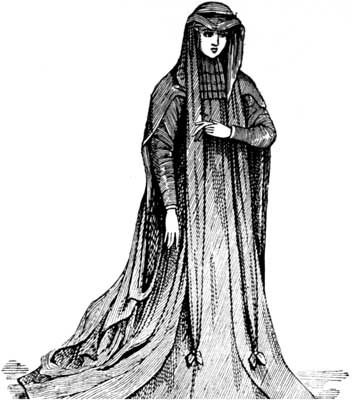 |
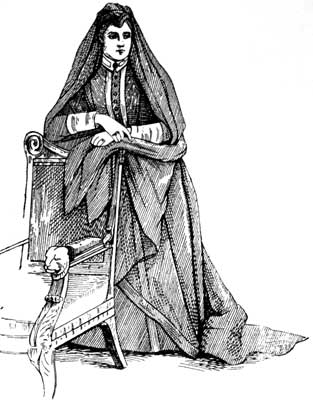 |
| FRENCH LADY OF 16TH CENTURY IN WIDOW'S WEEDS. | GERMAN WIDOW'S DRESS OF TO-DAY. |
Of late years, in this country, mourning has been considerably modified, particularly for the male sex, who often content themselves with a black hat-band and another on the left sleeve of dark-coloured clothes. By Scotch law, whether a man dies solvent or insolvent, his widow may claim out of his estate, sufficient for mourning suitable to her rank, and the same privilege applies to each of her children, who are old enough to be present at their father's funeral. This right takes precedence over any debts the dead man[Pg 57] may have contracted, and is a distinction not accorded to English, Welsh, or Irish widows.
In most European countries black is the accepted colour for mourning; though in different parts of the globe white, yellow, red, brown, and even blue garments are prescribed by custom as the emblem of death.
These shades have been selected for the following reasons:—Black is symbolical of the gloom which surrounds one when those who are nearest and dearest are taken. Black and white express sorrow mixed with hope, and white alone the light which follows the night of mourning. Blue, the tint of the heavens, to which it is hoped the spirit forms have taken flight. Yellow is typical of the dead autumn leaf, and brown the earth to which the body returns. Violet, a royal colour, is generally used for the mourning of kings and high dignitaries of the Church. Scarlet is also used for royal mourning occasionally.[A]
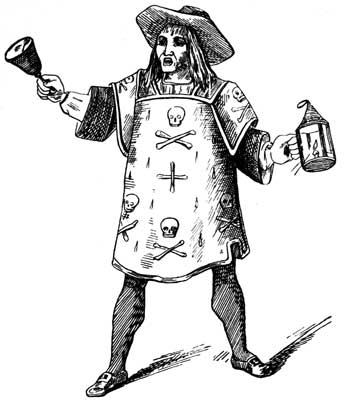 |
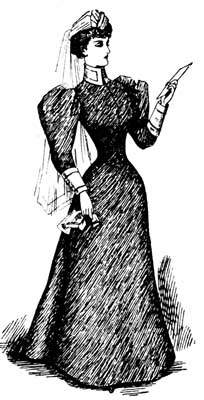 |
| THE DEATH CRIER. | ENGLISH WIDOW'S DRESS OF TO-DAY. |
[A] For permission to reproduce some of the drawings from
Davey's "History of Mourning," I am indebted to Messrs. Jay, Regent
Street, London.[Pg 58]
[Pg 59]
"The fashion wears out more apparel than the man."
—Much Ado about Nothing.
"Through tattered clothes small vices do appear,
Robes and furred gowns hide all."—King Lear.
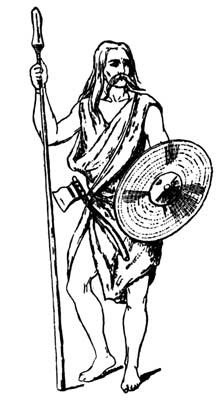 BRITON CLAD IN SKINS.
BRITON CLAD IN SKINS.
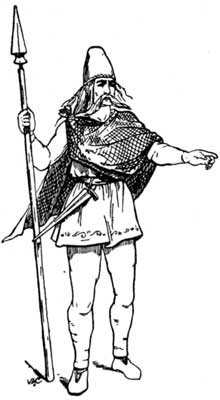 BRITON AT THE TIME OF THE ROMAN INVASION.
BRITON AT THE TIME OF THE ROMAN INVASION.
"Vanity, thy name is woman," "As vain as a woman," and similar epithets, are hurled at our defenceless heads by our teachers and masters; yet how few of them pause for a moment to consider whether they are altogether free from this human weakness or exempt from that love of dress which they so strongly condemn in others. It does not require a deep study of the history of costume to reveal some curious anomalies in this respect, and the sketches chosen for the purpose of illustrating this chapter will only give a faint idea of what has been considered appropriate and becoming to the manly form at different epochs. In Pelautier's "Histoire des Celtes," we learn that "the toilet of the ancient inhabitants of Britain, somewhat resembled that of the North American Indian of the present day, and consisted of a series of elaborate paintings over the whole surface of the body, which were no doubt originally intended to protect the skin, from the inclemencies of the weather, but were afterwards used as a mode of embellishment and a means of distinguishing the different classes, for it was reserved to freemen, and strictly forbidden to slaves. The lower classes confined themselves to small designs drawn at a considerable distance from each other; but the nobles had the privilege of ornamenting their persons with large figures, chiefly of animals, subsequently transferred to their shields, after they adopted a less scanty costume, and this may be looked upon as the origin of family arms." The Picts, who inhabited the north of Britain, were remarkable for their pictorial decorations, hence their name, derived from an ancient word, picti, which signifies painted. Our remote ancestors also added to their other charms (which were doubtless irresistible to the belles of that period), by deepening the tone of their naturally ruddy locks, by washing them in water boiled with lime. Their clothing was of skins of animals killed in the chase, and they were armed with implements of bone and flint. The Tyrian traders taught them how to construct various weapons of war from a composition of copper and tin, and their flat wicker shields were superseded by those of metal ornamented with concentric circles. After the Roman Conquest of Britain, the skin garments were laid aside for dyed tunics and close trousers. Over the tunic was worn a sagum, or short cloak, so named by the[Pg 62] Romans from saic, a word of Celtic origin, which signified a skin or hide. When the head was covered it was with a cap, from the British cab, a hut, which, from its circular shape, it somewhat resembled, for the dwelling-places were composed of wattles firmly fixed in the ground and fastened together at the top. A curious remnant of this fashion is the horn-like cap of rushes still made by Welsh children. The hair was usually long and flowing. Men of rank shaved the chin and allowed the moustache to grow to an extraordinary length.
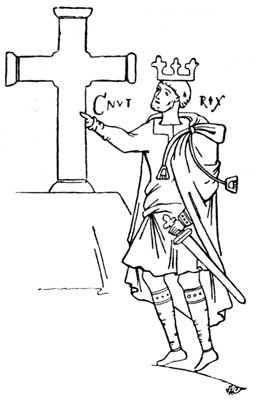 CANUTE.
CANUTE.
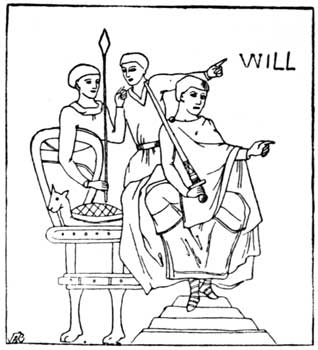 WILLIAM THE NORMAN, FROM BAYEUX TAPESTRY.
WILLIAM THE NORMAN, FROM BAYEUX TAPESTRY.
The Saxons and Danes are spoken of as wearers of "scarlet, purple, and fine linen," and the latter combed their hair once a day, bathed once a week, and frequently changed their clothing. By these means they found favour in the eyes of the women, and delighted the wives and daughters of the nobility. In a curious MS., written in the reign of King Canute, the monarch is represented in a tunic and mantle embellished with cords and tassels. The tops of his stockings are embroidered, but he wears simple leather shoes. A vestment presented by Canute to Croyland Abbey was of silk, embroidered with golden eagles, and the rich pall which he ordered to be laid over the tomb of Edmund Ironside, was "embroidered with the likeness of golden apples and ornamented with pearls." From this, we see that the needle played an important part in the ornamentation of clothing, and to it we also owe the splendid Bayeux tapestry, worked by Matilda, wife of William the Conqueror. This priceless curiosity is not only remarkable as a magnificent piece of workmanship, but affords a good idea of the dress of that period—the 11th century. A tunic reaching to the ankle, leg bandages and shoes, a flowing mantle and flat cap, were the chief characteristics of the civil dress of this and succeeding reigns. The Normans, however, were clean-shaven.
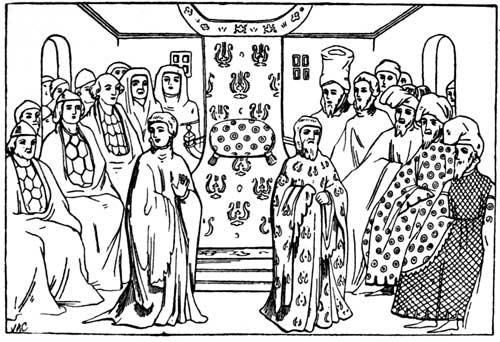 PARLIAMENT ASSEMBLED IN THE REIGN OF RICHARD II.
PARLIAMENT ASSEMBLED IN THE REIGN OF RICHARD II.
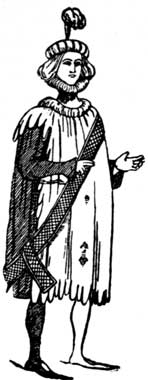 GENTLEMAN OF THE 14TH CENTURY.
GENTLEMAN OF THE 14TH CENTURY.
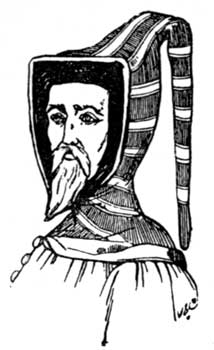 A CAPUCHON OR HOOD, TIME OF EDWARD II.
A CAPUCHON OR HOOD, TIME OF EDWARD II.
During the Middle Ages extravagance prevailed in both male and female costume. Handsome furs were in great request, and several times sumptuary laws were passed. Men wore eight indispensable articles of dress, the shirt, breeches, stockings, shoes, coat, surcoat or cotehardie, mantle, and head dress. The coat or under-dress corresponded with the tunic of the ancients, and was entirely hidden, with the exception of the sleeves, by the surcoat. There were two kinds of mantles, one open in the front, the two sides connected by a strap resting on the chest, the other was open on the right side and had one end thrown over the left shoulder. Head coverings were of various[Pg 63] descriptions; but many adopted hoods with long points, which were used to attach them to the belt when not in use. The assembling of Parliament in the reign of Richard II. gives the lay, spiritual, and legal peers in their usual costumes, and is reproduced from Planché's "History of British Costume." The Bishops are in cowls near the throne, the judges in coifs and furred robes, the Earls of Westmorland and Northumberland stand in front. The Duke of Hereford, in high cap, is to the left of the throne, and Exeter, Salisbury, and other peers are seated opposite the judges. During the reign of Richard II., which lasted over twenty years (1377 to 1399), there were many curious fashions in masculine attire. The peaked shoes, chained to the knee, were not more ridiculous than the deep, wide sleeves commonly called pokeys, which were shaped like a bagpipe and were worn by all classes. Many writers refer to them as the devil's receptacles, as whatever could be stolen was hidden away in their folds. Some were wide and reached to the feet, others to the knee, and they were full of slits. Hose were often of different colours. Parti-coloured suits were also in favour, and these were frequently scalloped at the edges and embroidered with mottoes and other devices. Chaucer, who wrote the "Canterbury Tales" towards the end of Richard's reign, describes in the most graphic manner the apparel of his contemporaries. "The haberdasher, carpenter, weaver, dyer, and tapestry worker, all wealthy burghers of the City of London, were clothed in a livery, and the handles of their knives, pouches, and girdles were ornamented with silver. The clergy were not to be distinguished from the laity, and rode on horseback, glittering with gold, in gowns of scarlet and green, fine with cut work. Their mitres embellished with pearls like the head of a queen, and staffs of precious metals set with jewels." Even the parish clerk is said to be "spruce and foppish in his dress." The author of an anonymous work called the "Eulogium," of this date, says:—"The commoners were besotted in excess of apparel. Some in wide surcoats reaching to their loins, some in a garment reaching[Pg 64] to their heels, closed before and sticking out at the sides, so that at the back they make men seem like women, and this they call by the ridiculous name gowne. Their hoods are little, and tied under the chins. Their lirri-pipes (tippets) pass round the neck, and hanging down before, reach to the heels."
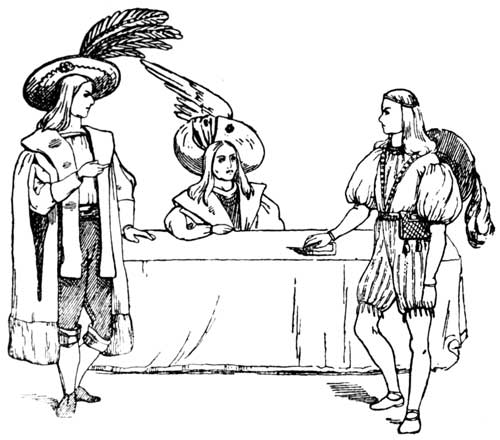 COSTUME OF THE REIGN OF HENRY VII.
COSTUME OF THE REIGN OF HENRY VII.
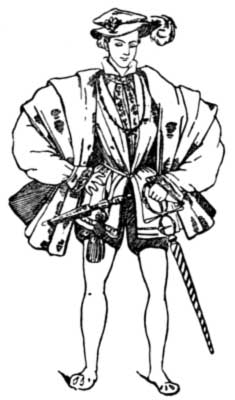 COURTIER IN THE REIGN OF ELIZABETH.
COURTIER IN THE REIGN OF ELIZABETH.
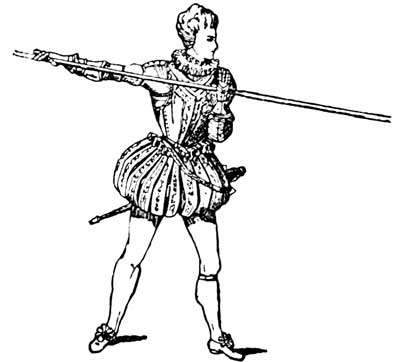 EARL OF SURREY, TIME OF HENRY VIII.
EARL OF SURREY, TIME OF HENRY VIII.
Towards the end of the 14th century men began to wear short clothes made to fit the body so closely that it often required the assistance of two people to remove them, and it is from this period we can distinctly trace the difference between ancient and modern dress; in fact, our present fashions—masculine and feminine—resemble to a certain extent those worn during mediæval times. Then, as now, men wore overcoats with tight sleeves, felt hats also with feathers, worn over a skull cap, and slung behind the back, and closely-fitting shoes and boots.
The Tudor monarchs paid considerable attention to the adornment of their persons, and were responsible for stringent legal enactments calculated to encourage home manufacturers. Felt hat-making—one of our oldest industries—was introduced into this country from Spain and Holland. A great impetus was given to this branch of trade by a law passed in 1571 which enjoined "every person above the age of seven years to wear on Sundays or holidays a cap of wool, knit made, thickened, and dressed in England by some of the trade of cappers, under the forfeiture of three farthings for every day's neglect." In 1603 the felt makers became a Corporation with grants and many privileges. Throughout the Middle Ages the upper classes frequently engaged in commerce. Bishops, abbots, and nobles personally superintended the disposal of the produce of their estates, and a considerable number of the younger sons of good families were the leading traders of the 15th and 16th centuries.
The "frocke" frequently mentioned, and of which the modern frock coat is the degenerate descendant, was a sort of jacket or jerkin made occasionally with skirts, a style associated especially, with Holbein's portraits of Henry VIII. and his contemporaries.
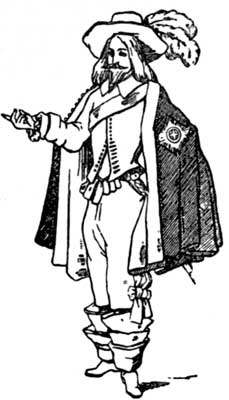 CHARLES I.
CHARLES I.
The uniform worn at the present day by the Yeomen of the Guard stationed at the Tower of London, gives us the military costume of the Tudor period. It is the oldest corps in her Majesty's service, and was instituted by Henry VII. as the bodyguard of the sovereign. In the dress of the Bluecoat Boys at Christ's Hospital we have that of the citizens of London during the reign of Edward VI. and Mary, when blue coats were habitually used by apprentices and serving men, yellow stockings also were in common use. The badges on the jackets of firemen and watermen date from this time; they were made of metal and placed on the sleeve, in the 16th century, instead of being embroidered on the back or breast of the garment as they had been previously. Retainers in the households of the wealthy, were provided with surcoats and mantles twice a year, of their patron's favourite colour, and this was called the livrée, from a French word signifying to distribute. Trade guilds and members of the learned professions, also adopted a distinct style of costume. Lawyers, who were originally priests, of course wore the tonsure; but when the clergy ceased to interfere with secular affairs the lay lawyer continued this sign of office, and also wore a coif. Their[Pg 65] gowns were capacious and lined with fur: and the Justices of the King's Bench were allowed liveries by the King, of cloth and silk. Budge, or lambskin, and miniver were provided for the trimming thereof, and the colour appears to have varied in different reigns, but for a long time green prevailed.
The courtiers of Elizabeth discarded the "frocke cote" for quilted and stuffed doublets and trunk hose, slashed and ornamented in the most quaint and extravagant manner. Below these were worn stockings embroidered with birds, beasts, and other devices, "sewed up close thereto as though they were all of one piece." Trunk hose were appropriately named, as they were often filled with wool, bran, and other materials. At last they became of such enormous size that it was necessary to construct swings in the Houses of Parliament in place of the ordinary fixed seats, for the accommodation of those wearing this singular article of attire. Enormous ruffs of muslin and lace encircled the necks of dandies of the Elizabethan era, and they appear to have had waists which would excite the envy of the belles of the latter part of the 19th century. In fact, the gallants of that day were even in advance of the fair sex, in their love of fantastic costume; and as Hollingshead, in The Chronicle, justly states in reference to the fashions of the period: "Nothing was more constant in England than inconstancy of attire."
A few years since, behind some ancient panelling at Haddon Hall, Derbyshire, was discovered a washing bill (with other things appertaining to the 16th and 17th centuries) which gives us a good idea of the various articles of dress then worn. Reference is made to the ruff, which is too well known to need description; to bandes made of linen and cambric, from which those now used by the clergy took their origin, and from which we derive the modern word bandbox. There were three kinds—some that stood upright, others were allowed to lie flat upon the shoulders, as shown in the drawings of Charles I. and II., and those which were embroidered and trimmed with lace. The shirt applied to the under-garment of both sexes, and the half-shirt referred to the stomacher over which the dress was laced. Boot hose were made of a variety of materials, and were occasionally called nether stocks; socks were sometimes put over them; and tops were of Holland linen or lace, and formed the lining of the full hanging boots of the Cavaliers.
During the Civil War the dress worn by the King's adherents, consisted of a doublet of silk or satin with loose sleeves, slashed up the front; the collar was generally of point lace, and a short cloak rested carelessly on one shoulder. The hat was a broad-brimmed beaver with a plume of feathers,[Pg 66] and trunk hose gave way to breeches. The Roundheads or Republican Party went to the opposite extreme. They cut their hair close, avoided lace and jewels, had plain linen or cloth suits of a grey or brown tint, with a hat somewhat resembling the modern chimney pot.
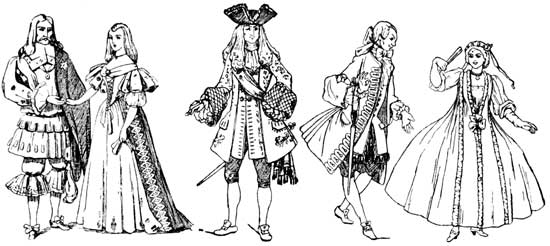
CHARLES II. AND HIS QUEEN (1662).—WILLIAM III. (1694).—GENTLEMAN AND LADY OF 18TH CENTURY.
About this period we also hear of the waistcoat, which was cut high at the neck, and was made with sleeves. Neckcloths and cravats of Brussels and Flanders lace were tied in a knot under the chin, and had square ends. Another peculiar feature of masculine costume towards the end of the 17th century consisted of petticoat breeches with drooping lace ruffles, such as adorn the nether limbs of Charles II. Patches and perukes were also adopted, and the former fashion, a revival of an old Roman custom, had political significance according to where they were placed on the face, and were bitterly ridiculed by numerous satirical writers. "I know many young gentlemen," says Middleton, in one of his plays, "who wear longer hair than their mistresses." The beard was worn in different ways, but the most usual shape was what Beaumont and Fletcher, in their "Queen of Corinth," call the T beard, consisting of a moustache and imperial:—
"His beard,
Which now he put i' the form of a T,
The Roman T; your T beard is the fashion,
And two-fold doth express the enamoured courtier."
Shakespeare also tells us, it was often dyed different colours.
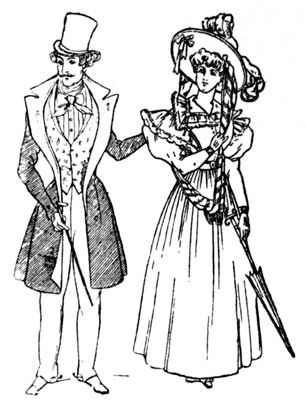 WALKING DRESS, 1830.
WALKING DRESS, 1830.
Everyone tried to rival his neighbour in the size of his peruke, till they became so preposterous that Charles II. showed his disfavour by writing a letter to the University of Cambridge forbidding the members to wear periwigs, smoke tobacco, or read their sermons. History does not relate what effect the King's censure had upon the head-gear of students attending the colleges, but it is absolutely proved that they paid no heed to his latter commands. It was the fashion for men to comb their perukes in public, and curiously-chased combs of bone and tortoise-shell, were carried in the pocket with the snuff-box, another[Pg 67] indispensable appendage of a fine gentleman.
In the 18th century the broad hat brims were turned up at the sides, and, in the racy vernacular of the day, "each gallant cocked his hat according to his fancy." Shoe buckles became general in the reign of Queen Anne, and displaced the ribbon rosettes formerly worn. Planché accurately describes the fashions of that day. "The square-cut coat was stiffened with wires and buckram, and the long-flapped waistcoat with pockets almost met the stockings. There were hanging cuffs with lace ruffles, square-toed shoes with red heels, and hats laced with gold or silver galloon."
At the beginning of the 19th century many important changes took place. Excepting for Court dress, cloth was substituted for velvet and other rich fabrics. The coat was open, displaying an elaborate shirt-front, stock and flowered waistcoat; and the skirt, though full, fell in natural folds. Trousers were very tight, and held in place by a strap beneath the foot, and hats displayed narrow curved brims.
We have only to cast our eyes down the vista of ages to find that
British costume has been suited to the needs, habits, and customs of the
people, and periods at which it was worn. Skins of animals were
appropriate to the hardy cave dwellers who inhabited this country at an
early period in the world's history. The simple dress of the
Anglo-Saxons fulfilled the requirements of a primitive race; and the
furs and rich fabrics brought home by the Crusaders were adapted to the
higher state of civilization which prevailed in the Middle Ages. In the
16th century the Renaissance (of art and culture) was specially noted
for richness of attire. During the 18th century a mixture of styles
which had found favour with previous generations was the most marked
feature in the costume of that period, and this equally applies to the
two first decades of the present one. Masculine attire at the present
day, though simple and practical, has few points of beauty to recommend
it. Briefly, it resolves itself into a series of woollen cylinders which
changeth not from generation to generation.[Pg 70]
[Pg 68]
[Pg 69]
"The childhood shows the man,
As morning shows the day."—Milton.
Of children's dress in olden times we have singularly few details, and, as a rule, it may be concluded that their raiment was fashioned on similar lines to that worn by the men and women of the country in which they lived, and was more or less ornamented, according to their station in life.
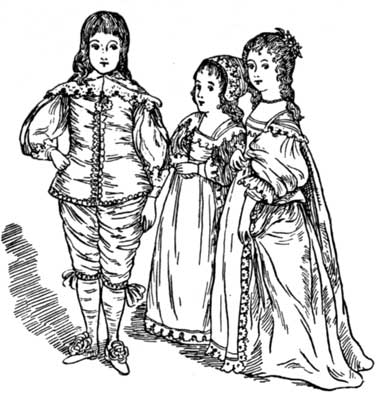 CHILDREN OF CHARLES I.
CHILDREN OF CHARLES I.One or two biblical references enlighten us as to Eastern customs. On the authority of St. Luke, our Saviour in infancy was wrapped in swaddling clothes. "Samuel," we are told, "being a child, was girded with a linen ephod," which appears to have been a close robe or vest reaching from the shoulders to the loins, and confined by a girdle. Considering the climate and the habits of the people, it was probably the only garment used in summer, but in cold weather was supplemented, we presume, by the little coat his mother bought him from year to year, when she and her husband came to offer the annual sacrifice, at Shiloh, where Eli, the High Priest, lived. A coat of many colours was also presented to Joseph in his youth as a mark of Jacob's affection for the child of his old age.
Greek and Roman children of the gentler sex are usually represented in the chiton, or loose classical gown, combined with a shawl or himation weighted at the four corners, so as to assist the wearer in adjusting it. How to put on this garment was carefully taught as part of a girl's education. The long end was first thrown over the left shoulder. The front part was arranged in folds across the body, passed under the right arm and over the left shoulder or forearm. The girdle sometimes consisted of a cord, at others of metal bands, and by drawing the chiton over it, a double thickness of the fabric covered the vital organs of the body. Boys wore the tunic and toga, and the latter is supposed to have been oblong, with the corners rounded off, so as to give a semicircular effect. Hats were not commonly worn, except by the poor or when on a journey, a fold of the toga or mantle serving for a head covering, and sandals protected the feet.
The Egyptian labouring classes allowed their children to be nude, and infants were unfamiliar with swaddling clothes. The working man and boy had simply a loin cloth and girdle, and the girl a loose tunic fastened with strings at the neck and reaching to her feet. On the other hand, children of the upper classes in Egypt were repetitions of their elders on a small scale. Girls wore a linen skirt embroidered in colours and fastened with a bright sash, or suspended from the shoulders, and over this a loose transparent robe with long sleeves. The male costume consisted of a loin cloth, and a full robe with short sleeves, or a tunic, and both sexes had elaborately curled or plaited wigs, as the natural hair was only allowed to grow in times of mourning.
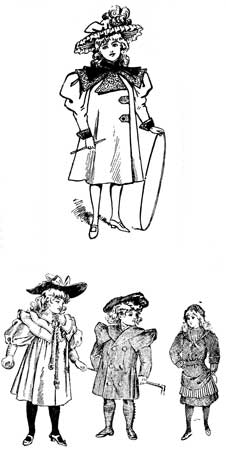 CHILDREN'S COSTUME, PRESENT DAY.
CHILDREN'S COSTUME, PRESENT DAY.
The Roman occupation of Britain left its impress for a long period on the costume of the Anglo-Saxon race. The long-sleeved banded tunic was the usual habit of the industrial classes through the Middle Ages and leg bandages and cross gartering preceded[Pg 72] breeches. Quite young boys appear in this dress, and little girls are seen in ancient MSS. in the kirtle and gunna, the equivalents of the modern petticoat and dress. Their hair, however, was allowed to fall naturally, or was dressed with two pendant plaits, and was not concealed, as was so often the case with adult females, by means of the head-rail. The materials used in clothing were to a great extent the produce of household industry. The women servants were employed in spinning, weaving, and sewing, and ladies of the highest rank did not disdain to participate in such labours. Several articles of dress were derived from the tanner, who worked up his leather into shoes, ankle leathers, and leathern hose. The art of tanning skins with the wool or hair on, was also practised, and dyeing was in great request, for in a rude age a love of gaudy colours is a natural characteristic of the people. The most skilful artificers were found in the religious houses, but under each landowner serfs were trained in the mechanical arts. Silk was worn by the wealthy, but the common materials for wearing apparel in this country were cotton, linen, and woollen.
Among the Anglo-Saxons and their pagan ancestors the desertion of children sometimes occurred, but as the influence of Christianity increased, it was regarded as a crime, and a law was passed for its repression. For fostering a foundling the State allowed 6s. the first year; 12s. the second; and 30s. for the third year; and afterward the foster parent was to receive a sum varying according to the appearance of the child. Children bereft of their father, remained under the mother's care, but until the eldest child became of age were subject to the guardianship of the husband's relations. Mothers usually nursed their own children, cradles were used, and for the first few months their clothing was swathed with a bandage. In this compact form they were more easily carried, though the constraint to which they were subjected, probably prevented that free development of the limbs, which we now consider so essential to health and beauty. If very poor, the father[Pg 73] was allowed to sell his son into slavery for seven years, providing the consent of the child was obtained, and one ten years old could give evidence. Until a daughter was fifteen years of age, her father could marry her as he pleased, but afterwards had no power to do so. A boy of fifteen could enter the monastic life if so disposed, and a girl at a somewhat later period. Monasteries offered the best education then procurable, and the clergy were directed to "teach youth with care, and to draw them to some craft." Schoolboys appear to have been kept in order, by the dread of personal chastisement, and great respect and reverence was exacted by their elders.
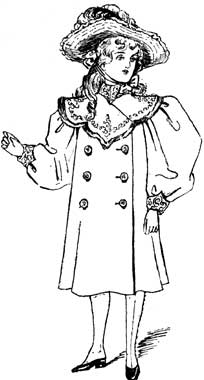
In the dress of the Blue-coat School (Christ's Hospital), we see the ordinary costume of boys of the Tudor period. It consisted of a long coat reaching to the heels and knee-breeches, a striped vest, yellow stockings, and a small round cap placed on the side of the head. The dress of little girls may be found on various monumental effigies, in which they appear like their mothers, in full skirts, sometimes distended by a fardingale, the body imprisoned in whalebone to the hips, a folded ruff encircling the neck, and their stockings (according to Stubbs) were of the finest yarn, silk, thread, or cloth that could possibly be had, of changeable colours, cunningly knit, with curiously indented points, clocks, and open seams. The shoes were of black, green, white and yellow velvet, or of leather stitched with silk and embroidered with gold and silver all over the foot.
The paintings of Vandyck bring graphically before us the picturesque elements of the dress of the Stuart era. There is an air of richness and refinement about the long skirted silken[Pg 74] frocks embellished with lace, the pointed collars, and beaver hats with trailing feathers universally worn, and the quaint lace caps, which, by a turn of fashion's wheel, have been remodelled for the children of today.
At no period in the history of costume were the styles so offensive to those with a true conception of colour and form than in the first half of the nineteenth century. We have only to turn to the sketches of Leech and contemporary artists to find bare necks and arms, conspicuous underwear, very short skirts distended by a stiffened petticoat or crinoline, white cotton stockings, low shoes fastened by a strap and single button, mushroom hats, aprons and pinafores devoid of elegance and grace, and the hair cut close to the head or arranged in rows of stiff ringlets. Nor did the boys of England, in trousers buttoned high on short jackets, or with tunics worn with frilled linen collars and leathern belts, show to greater advantage. Queen Victoria inaugurated a new system of clothing for boys, when she dressed the young Princes in Scotch and sailor suits, and the wardrobes of all classes have been considerably extended of late, by the open-air life and outdoor sports in which every self-respecting lad indulges. Cricket, tennis, boating, football, and cycling, all imperatively demand appropriate apparel, and tailors now give reasonable attention to this important branch of their business, and provide fabrics and designs suited to the needs of the rising generation.
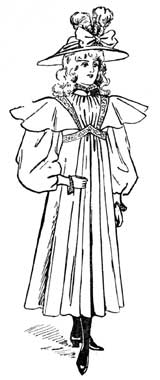
Habits of personal cleanliness and the influence of dress on the minds of growing girls is hardly realized except by those directly concerned in education. Many a sensitive child's character has been warped by the thoughtless jeers of schoolfellows, who were quick to perceive that her clothing[Pg 75] was not up-to-date or of such good material as their own. On the other hand, vanity, envy, and uncharitableness have been engendered by foolish mothers, who have provided their daughters with inappropriate and extravagant outfits.
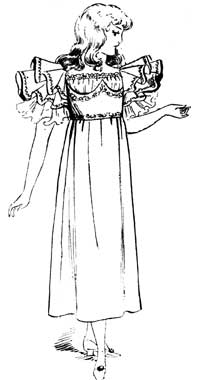
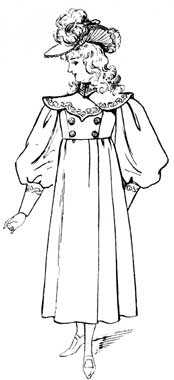
Though many advocate uniforms with distinctive trimmings for girls' colleges, there are drawbacks to the scheme being adopted. Such a course would probably destroy the individuality which we all desire to see applied to the choice of clothing, and it would leave no field for original ideas. Children must be trained to select and wear their clothes to the best advantage, and it is folly to think that they will do so by intuition. Some may possess naturally an artistic sense and a keen eye for colour, but they are certainly in the minority, and rational dress reformers have pushed sensible ideas to the verge of absurdity, till now the name is almost regarded as a term of reproach.
How much we owe to pioneers of children's dress reform, and especially
to Messrs. Liberty, who evolved what is generally known as the æsthetic
style in dress. From sketches courteously placed at my disposal, I am
enabled to put before the reader examples of children's clothing which
are artistic in form, light of texture, and which in no way impede the
physical development. Those who have the care of children should
remember what a sacred charge is imposed upon them, and that their
future health mainly depends, upon the manner in which they are clothed
during the first few years of life. There must be no tight bands, belts,
or garters to prevent circulation and to cause organic troubles; and
where corsets are dispensed with, as happily they are in many cases
where growing girls are concerned, the weight of the clothing should be
borne by the shoulders, not the waist, and this is ensured by cutting
undergarments in the princess or combination forms. Many young people
suffer from being carelessly shod, and hideous malformations of the feet
arise in consequence, while obscure diseases of the brain can sometimes
be traced to heavy head-gear, and the strain of over-study. Hats should
be of light construction, and afford a grateful shade to the eyes, if
that far-reaching ailment of[Pg 76] civilisation, short sight, is to be
successfully combatted; and special attention must be paid to infants,
who may often be seen in public thoroughfares with a hot sun beating
down upon them, and the nurse oblivious to the fact. The sight of a
tender infant entrusted to the care of a young woman, who has not the
glimmering of a notion of how to look after its fragile body, must fill
any right-minded person with indignation. Is it unreasonable to expect
those who undertake the charge of children to acquaint themselves with
at least an elementary knowledge of the construction and functions of
the human body? The ignorance of the average nursemaid is appalling;
and though a board school education may have acquainted her with the
mysteries of the First Book of Euclid, or the rudiments of music, the
curriculum rarely includes the simplest instruction on the healthy
training of children; and, in consequence, the high rate of infant
mortality in this country is a national disgrace.[Pg 77]
[Pg 78]
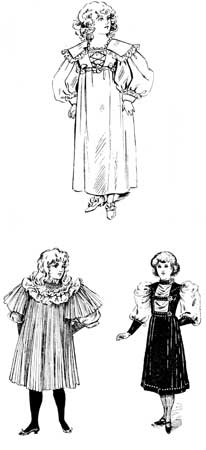
"The dome, where pleasure holds her midnight reign,
Here richly decked, admits the gorgeous train;
Tumultuous grandeur crowds the blazing square,
The rattling chariots clash, the torches glare."
During the Roman occupation of Britain, many sports and pastimes, with their appropriate costumes, were introduced into this country from Southern Europe and the East, and at a very early period mummings were popular with the people. These were primitive masquerades, where the actors, if we may judge from antique illuminations, generally mimicked the brute creation rather than human beings. They often appeared between the courses at banquets, and on important occasions elaborate pageants were arranged. Ships filled with mariners were sometimes introduced, or towers garrisoned with armed men, while the actors portrayed some allegorical lesson or historical incident.
A well-known event intimately connected with masking was the narrow escape from death by fire of Charles VI. of France, on January 29th, 1392. The king, with eleven of his knights, for the amusement of the Court, dressed like savages, in tight-fitting garments of linen covered with flax, and were dancing before the Queen and the Duchess de Berri, when the Duc d'Orléans with a torch accidentally ignited the inflammable costume of a masker, who was chained to four others. The Duchess protected the King by wrapping him in the train of her mantle, but four persons died in great agony.
Edward III. issued an ordinance against vagrants who exhibited scandalous masquerades in low ale-houses, and directed that such persons should be whipped out of London. The Feast of Fools was one of the most singular of these exhibitions. It somewhat resembled the Roman Saturnalia, and was enacted at Christmas. In England the celebration of this festival does not appear to have been attended with the same excesses as were commonly practised on the Continent, but it was nevertheless a season of licence, in which order and discipline were reversed. The churl was elected to represent the Pope; the buffoon was made a cardinal; and the lowest of the mob assumed for the time being the garb of the priesthood, and took possession of churches, where they parodied every part of the sacred service, and sang masses composed of obscene songs.
Dramatic representations were so tainted by the grossness and licentiousness of the age, that priests were prohibited from attending them, till the Church introduced religious plays, founded on scriptural incidents, and which were known as miracles and mysteries. For these the actors were trained by the clergy, and sacred edifices and vestments were placed at their disposal, to give truth and lustre to the representations.
There were frequent tournaments after the Norman Invasion, and these were patronized and encouraged by Richard C[oe]ur de Lion. From this era they occupied a prominent place in the national institutions and history, and afforded many opportunities for the display of picturesque costume. Ladies on these occasions were conspicuous, and sometimes rode in parti-coloured tunics with short hoods and tippets wrapped about their heads. Their girdles were decorated with gold and silver, and they carried small swords. The space marked out for the combat was surrounded by raised seats for high-born dames, princes, and the judges of the conflict. Knights wore their ladies' colours on their helmets, emblazoned on their clothing, and on the trappings of their horses; and throngs of troubadours, heralds, and minstrels dressed in gorgeous attire, were present to discharge their duties, and to give importance to the spectacle.
The ancient English Morris Dance, performed with other quaint usages on the 1st of May, is supposed to be of Moorish origin. It is depicted on an antique stained glass window at Betley, in Staffordshire. The May-pole and the Man with the Hobby Horse (who represents a Moorish King, and is the consort of the May Queen), occupy a prominent position. The other characters[Pg 80] are the Fool, the Lesser Fool, Tom the Piper, a Spaniard, the Franklin or private gentleman, a Churl or peasant, the May Queen, a Nobleman, and a Friar. The dresses were adorned with bells, intended to sound the measure of the dancers. They were of different sizes, and were called the fore bell, the second bell, the treble, the tenor, and the great bell.
Planché, in his valuable work, the "Cyclopædia of Costume," states the earliest illustration of a bal costumé is in a MS. of the fifteenth century, in the Ambrosian Library at Milan, and he gives a reproduction from an old painting on wood dating from 1463, representing a dance by torchlight at the Court of Burgundy. Each person holds a long lighted taper, and this dance, up to the sixteenth century, was usually reserved for wedding festivities. In England masked balls were rare before the reign of William III., and in France they first took place during the regency of Philip, Duke of Orleans, when the Opera House was converted into a ball-room. Father Sebastian, a Carmelite friar, devised a means of elevating the floor of the pit to the level of the stage, and of lowering it at pleasure.
Ranelagh and Vauxhall Gardens, and Belsize House, Hampstead, were also places of popular resort, and scenes of many entertainments during the eighteenth century. There were pyrotechnic displays, bands of music, frequent balls, and facilities for dinner and supper parties. The lawns were dotted with arbours, lakes, and artificial cascades; the trees were festooned with coloured lamps, and the costumes of those who frequented these gatherings were elaborate and costly.
From the writings of Horace Walpole and others, we learn that private open-air galas were of common occurrence among the aristocracy, and he gives a description of a festino at Northumberland House in honour of the Marquess of Tavistock and his bride; when arches and pyramids of lights alternately surrounded the enclosure, and festoons of lamps edged the railings. In 1761 Her Majesty Queen Charlotte surprised her husband on his birthday with a splendid garden party, followed by fireworks, a cold supper of a hundred dishes, and an illuminated dessert. The Duke of Richmond celebrated a similar occasion with a masked ball and music—the vocal parts performed by many of the nobility, in fancy dress. Here, too, there was a display of fireworks in the garden and from the river. Almack's new Subscription and Assembly Room was opened in February, 1765, under distinguished patronage; and Gibbon mentions a masquerade at a rival establishment, the Pantheon, which he states was above par in magnificence, and below par in humour, and cost £5000.
Five o'clock was the dinner hour of fashionable people during the eighteenth century, and three for those of lower rank. At eleven p.m. supper was usually served, and breakfast was from nine to eleven a.m. The House of Commons commenced sitting at two, and the Opera began at seven.
At this period the domino (evolved from the priestly cowl) was in great request, and was used in the boxes of theatres for purposes of concealment, and by those of questionable morals. Though the large hoop towards the close of the eighteenth century was only worn at Court, or in full dress, the pocket hoop for distending the panniers was still in vogue. For the abolition of the Court hoop, we are indebted to George IV., whose taste in dress was unimpeachable. Powder and patches maintained their ground till 1793, when they were discarded by Queen Charlotte and the Princesses. Aprons were regarded as a necessary item of a fashionable costume up to 1750, and the watch and etui adorned the waist, necklaces sparkled on the bosom, and bracelets were worn over long gloves.
The French Revolution affected masculine costume; and in 1789 were introduced into this country the muslin cravat, in which the chin was partially concealed, stand-up collars, Hessian boots, and round hats of beaver. Scarlet coats were much in vogue about 1784, and an anecdote in "The Life of Sir Astley Cooper" represents him as returning from a dancing academy in a scarlet coat, a three-cocked hat, a black glazed stock, nankeen knee-breeches, and silk stockings. This may be regarded as the ordinary costume of a gentleman at that period.
Wigs had begun to go out of fashion as early as 1763, in which year the wigmakers petitioned King George III. to support the trade by his example. "The hair," says Malcolm, "was dressed high on the head, whitened with powder, and alternately plaited[Pg 81] and turned up or queued behind." When the hair powder tax—one guinea per annum—was enforced in 1795, thousands of heads reverted to their natural colour.
Some brilliant fancy dress balls (with a view to encouraging home trade) have taken place during the Victorian era. Of the first, which was given by the Queen and Prince Consort at Buckingham Palace in 1842, a permanent memorial exists in two handsome volumes compiled by J. R. Planché, containing carefully coloured illustrations of the various dresses, and autograph portraits of the wearers. They form an invaluable book of reference for those desiring accurate representations of the costume of the period of Edward III. (1327-1377). A special feature of this ball was a series of costume quadrilles, arranged by ladies of the Court and others of high rank. They were danced in the following order:—
French quadrille, led by H. R. H. the Duchess of Cambridge.
Spanish quadrille, led by the Duchess of Buccleuch.
German quadrille, led by the Duchess of Sutherland.
Crusaders' quadrille, led by the Marchioness of Londonderry.
Waverley quadrille, led by the Countess de la Warr.
Scotch quadrille, led by the Duchess of Buccleuch.
Cossack quadrille, led by Baroness Bremon.
Greek quadrille, led by the Duchess of Leinster.
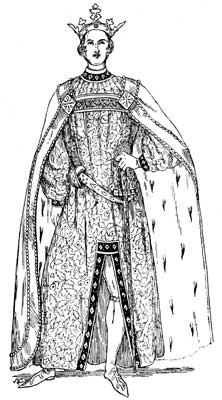 PRINCE ALBERT AS EDWARD III.
PRINCE ALBERT AS EDWARD III.
Prince Albert, as Edward III., wore a costume copied from the effigy of that king in Westminster Abbey. It consisted of a long tunic of gold and blue brocade, reaching to the ankles. The collar, which fitted close round the neck, was bordered with purple velvet, thickly studded with jewels. The tunic, which had an opening up the centre to the height of the knee, was bordered and enriched with jewels to correspond with the collar, as were the wristbands. The hose were scarlet, also the shoes, which were embroidered with gold. Over the tunic, His Royal Highness wore a mantle reaching to the heels, composed of the richest scarlet velvet, bordered by a broad gold figured lace, set on each side with large pearls. It was lined with ermine, and connected across the breast by a band of purple velvet, studded with diamonds, rubies, and emeralds, and in the centre was a turquoise of immense size and perfect colour.[Pg 82] The band was fastened to the mantle on either side by a massive gold ornament enriched with precious stones.
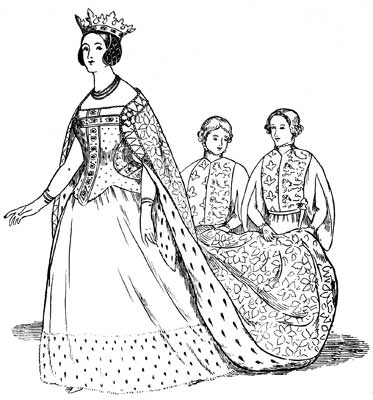 QUEEN VICTORIA AS PHILIPPA, WIFE OF EDWARD III.
QUEEN VICTORIA AS PHILIPPA, WIFE OF EDWARD III.
Her Majesty the Queen as Philippa of Hainault, wife of Edward III., was attired in a demi-trained skirt of crimson velvet, edged with miniver. Over this was worn a surcoat of blue and gold brocade, trimmed with fur to match, and embellished with a stomacher of jewels valued at £60,000. The other portions of the costume were also studded with jewels. The mantle was of gold brocade, with a floral design in silver. The hair was encased in a gold net, enriched with precious stones, and was surmounted by a crown.
Princess Augusta of Cambridge personated Princess Claude, daughter of Anne of Bretagne, Queen of France. Her dress of silver tissue was bordered with ermine, and the tunic was of light blue velvet, worked with the fleur-de-lis in silver. The low bodice was bordered with diamonds. The sleeves of silver tissue reached to the wrist, and were trimmed with rows of pearls. The gloves were jewelled, and a white tulle veil with silver embroideries depended from a turquoise and pearl diadem. By Her Majesty's command, her own dress, that of Prince Consort, and most of the costumes worn at this ball, were manufactured by the silk-weavers of Spitalfields.
For the second royal ball in June, 1845, the period of George II. (1727-1760) was selected, and 1200 guests were invited. The Queen looked extremely well in powder, and her dress is described as of cloth of gold and cloth of silver, with daisies and poppies worked in silk, and shaded in natural colours. The trimmings and ruffles of exquisite point lace—had belonged to Queen Charlotte—and the stomacher was trimmed with lace and jewels. The sacque was ornamented with ribbons, caught with diamonds. On the powdered coiffure was a diamond crown; Her Majesty's white shoes had red rosettes with diamond centres, and she wore the star and ribbon of the Order of the Garter. Prince Albert had a costume of the same period, with the Star of the Garter,[Pg 83] and the Order of the Golden Fleece in brilliants. The Marchioness of Douro, the Duke of Wellington's daughter-in-law, was the acknowledged belle of this ball, and wore £60,000 worth of diamonds. Miss—now the Baroness—Burdett Coutts was also present, her dress trimmed with jewels once the property of Marie Antoinette.
In 1871 the Princess of Wales attended the Waverley Ball at Willis' Rooms, with several other members of the Royal Family, and was much admired in the character of the ill-fated Mary Stuart. On July 22nd, 1874, a fancy dress ball was given by their Royal Highnesses the Prince and Princess of Wales at Marlborough House, for which some beautiful costumes were prepared. The Princess wore a handsome Venetian dress, and danced in the first quadrille with the present Duke of Devonshire. The Prince in a Cavalier costume opened the ball with the late Duchess of Sutherland. The chief costume quadrilles on this occasion were the Venetian, the Vandyck, Characters in Fairy Tales, and a Pack of Cards.
Another historic bal costumé was given in February, 1895, at Warwick Castle, by the Earl and Countess of Warwick. No more fitting background for such a function can be imagined than this stately mansion, which has been a centre of hospitality for countless generations, but has never been presided over by no more gracious and popular châtelaine than the present Countess. Lady Warwick looked very beautiful as Marie Antoinette (the consort of Louis XVI. of France) in a petticoat and corsage of exquisite English brocade, with a design of shaded roses, enriched with gold thread on a pearl-coloured ground. The train of royal blue velvet, embroidered in gold thread with the fleur-de-lis, was attached to the shoulders by a band of diamonds; and the Warwick jewels, diamond stars, were arranged on the corsage veiled with gold flecked gauze, which was also employed for the puffed sleeves. Her elaborate white coiffure was surmounted by a white muslin cap edged with blue velvet and adorned with diamond aigrettes and plumes of pink, white, and blue feathers. Lady Marjorie Greville (the only daughter of Lord and Lady Warwick) with Miss Hamilton acted as train-bearers. They wore the daintiest white costumes of the period, composed of broché silk, with fichus of white chiffon, and silk hats trimmed with feathers. Each carried a long crook tied with white ribbons and bunches of flowers, and the effect was charming. The Earl of Warwick wore a French Court costume, the coat of ruby velvet profusely trimmed with gold lace, white cloth cuffs, and revers. The long white kerseymere waistcoat was braided in gold, and the white knee-breeches and low shoes were ornamented with diamond buckles. The Earl's wig, a la mousquetaire, was tied with a bow of black ribbon, and he carried a tricorne hat with white ostrich plumes, and white gauntlet gloves. Lady Warwick's two sisters, the Duchess of Sutherland and Lady Angela Forbes, represented Marie Letzinka, consort of Louis XV., and Lady Mary Campbell. The former wore a magnificent gown of white satin de Lyon. The skirt embroidered with a flight of swallows in silver and crystals, a deep bertha of Point de Flandre, with ruffles of the same on the short sleeves. The train of crimson velvet was embroidered with the French emblem, and Her Grace had a stomacher of splendid diamonds. Lady Angela Forbes' dress was of white muslin, with a blue sash, and picturesque hat of turquoise silk, trimmed with feathers and roses. Princess Henry of Pless, as la Duchesse de Polignac, had a dress of rich white satin, the skirt embroidered 18in. deep, with turquoises and brilliants, a powdered wig, and the same jewels in her hair. Lady Eva Dugdale, sister to the Earl of Warwick, and lady-in-waiting to Her Royal Highness the Duchess of York, wore a Louis Quinze white satin dress, covered with pink roses, corsage en suite fastened with large diamond ornaments. A silver trellis pattern was worked round the hem of the skirt, and white silk mittens and shoes completed the costume. Lady Rosslyn chose a white embroidered muslin petticoat, the overdress of pink and red striped silk, fichu and ruches of black lisse, and a picturesque hat. Lady Flo Sturt, as Madame la Marquise de Pompadour, was in rich cream satin, with bodice and sleeves of antique lace, and stomacher of diamonds. A black satin toque, with aigrette of diamonds, contrasted well with the white wig. Count Deym, the Austrian Ambassador, was in English Court dress. Prince Henry of Pless, in mousquetaire cos[Pg 84]tume, represented the Vicomte de Bragelonne. The Duke of Manchester was in white satin breeches, waistcoat to match, bordered with gold, and coat of white and silver brocade with moss roses and foliage.
The scene inside the Castle was one of unparalleled brilliancy, while those who glanced from the mullioned windows saw by bright moonlight the Avon frozen, the ancient cedars glistening with frost, and the surrounding country wrapped in a snowy mantle. The entire ground floor of the Castle was thrown open, and no pains were spared to give as complete a representation as possible of the gorgeous fêtes which made the Court of Marie Antoinette famous throughout Europe. The finest spectacle presented itself when the guests assembled at supper in the oak-lined hall, where the light of a thousand candles was reflected in the bright steel armour which surrounded the walls. Several high screens, hung with Beauvais tapestry and shaded by huge palms, filled the angles of the hall, and the stone walls were partially concealed by yellow and silver embroideries. In the huge fireplace logs crackled, and on small round tables were placed silver candelabra with crimson shades and floral decorations, consisting of scarlet geraniums and maiden-hair fern. The centre table was reserved for Marie Antoinette and her Court, and here was the choicest display of family plate, including, amongst other valuable specimens of the goldsmith's art, a golden cup modelled by Benvenuto Cellini. From the hall you entered the Red Drawing room, which contains a marble table, inlaid with flowers and fruit, and formerly the property of Marie Antoinette. Next is the Cedar Drawing-room, used as the ball-room, on whose walls are many family portraits and other paintings by Vandyck; the remainder of the suite of State apartments were used as withdrawing-rooms between the dances; and at the opposite end of the Castle is the Library, the Billiard-room, and the Countess's lovely Louis Seize Boudoir, in ivory tints, with festoons of delicately-shaded flowers.
Dancing was carried on with great spirit till early morning, and the tardy winter sun had risen ere the last carriage drove away from one of the most successful balls of the nineteenth century.
Among the many important entertainments given by members of the English aristocracy in honour of the sixtieth year of the reign of Queen Victoria, was a Costume Ball at Devonshire House, Piccadilly, on July 2nd, 1897, when the Duke and Duchess of Devonshire received nearly all the members of the Royal Family, many distinguished guests from the Colonies, and members of the Corps Diplomatique. This historic mansion was built for the third Duke of Devonshire, and it was here that Georgiana, the beautiful Duchess of Devonshire, held her Court. It contains a fine suite of reception rooms on the first floor; a gallery of pictures, in which the old masters are well represented; and extensive grounds in the rear, which on this occasion were decorated with thousands of Chinese lanterns and fairy lamps. The principal feature of the ball was a grand procession of the guests, headed by the Duke and Duchess of Devonshire, the former personating Charles V. of Germany, and the latter attired with Oriental magnificence as Zenobia, Queen of Palmyra, in a robe of silver tissue wrought with jewels. The mantle was of cloth of gold similarly treated, and the bodice was also studded with precious stones. The head-dress consisted of white ostrich plumes and a golden and jewelled crown, from which depended chains of pearls. H.R.H. the Princess of Wales, as Margaret of Valois, was surrounded by the ladies of her Court, their Royal Highnesses Princess Charles of Denmark, Princess Victoria of Wales, the Duchess of Fife, and the Duchess of York. The Princess of Wales wore a gown of white satin wrought with silver, and a train of cloth of gold lined with silver and superbly jewelled. H.R.H. the Prince of Wales, as Grand Master of the Knights Hospitallers of St. John of Jerusalem and Chevalier of Malta, wore a rich Elizabethan costume carried out in black and silver, and bearing the white cross of the Order on one shoulder. The Duke of York represented the Earl of Cumberland, one of Queen Elizabeth's courtiers. Prince Charles of Denmark was a Danish student. The Duke of Connaught wore the uniform of a military commander during the reign of Elizabeth, and the Duchess looked charming as Queen Anne of Austria in a picturesque gown with puffed sleeves. The Eastern Queens were magnifi[Pg 85]cently arrayed and blazing with jewels. Lady de Trafford was Semiramis, Empress of Assyria, in a dress copied from a vase in the British Museum. Princess Henry of Pless was Queen of Sheba, in a robe and train of shot purple and gold tissue, elaborately embroidered with turquoises and other stones, and wore an Assyrian jewelled head-dress, decorated with a diamond bird and aigrette. Another Queen of Sheba was Lady Cynthia Graham, and there were two Cleopatras—Lady de Grey and Mrs. Arthur Paget. The husband of the latter accompanied her as Mark Antony. Lady Elcho was a Byzantine Queen, Miss Muriel Wilson was Queen Vashti, and the Countess of Dudley, as Queen Esther, wore a dress of white crêpe, embroidered with gold and studded with amethysts, turquoises, and pearls.
The Elizabethan Court was represented by Lady Tweedmouth as Queen
Elizabeth, in a gown copied from a picture in the National Portrait
Gallery. Her canopy was carried by four yeomen in uniforms of crimson,
black, and gold, copied from Holbein's picture of "The Field of the
Cloth of Gold," in the Hampton Court collection. Lord Tweedmouth was the
Earl of Leicester, in slashed doublet and hose of ruby velvet and satin,
enriched with gold embroidery. Lady Edmondstone, as Mary Queen of Scots,
wore a dress of pale blue velvet, and tulle veil head-dress and ruff
worked with pearls. She was attended by the Duchess of Hamilton, dressed
in the character of Mary Hamilton, the Queen's favourite maid of honour.
The Countess of Warwick, as Marie Antoinette, was beautifully dressed in
a petticoat of rich white satin and a Court gown of English brocade,
with a train of Royal blue velvet. The hair was powdered, and she was
attended by four pages in white satin suits and three-cornered hats,
bearing over her ladyship a canopy of blue velvet. This group included
the Duchess of Sutherland, as Charlotte Corday in a gown of red crêpe
de Chine, a muslin fichu and cap, trimmed with point d'Alençon lace,
and dagger at waist. Lady Westmorland made a lovely Hebe, and Lady
Angela Forbes, as the Queen of Naples, wore an Empire gown of ivory
duchesse satin, embroidered with silver and diamonds, and a train of
lilac velvet, edged with jewelled embroidery and lined with satin. The
head-dress consisted of a small jewelled crown and two white feathers.
Among many other notable costumes should be mentioned the Marchioness of
Tweedale's, as the Empress Josephine, as she appears in the Coronation
picture at the Louvre, Paris; the Marchioness of Londonderry, as the
Empress Marie Thérèse, of Austria, and the Marchioness of Zetland's, as
Queen Henrietta Maria, wife of Charles I. of England; Viscountess
Raincliffe, as the Empress Catherine II. of Russia, wore white satin,
and her dress was an exact copy of the picture in the British Museum by
Lambi. The Court gown of the Duchess of Portland, as Duchesse de Savoia,
who headed the Venetian procession, was composed of white satin veiled,
with lisse wrought with silver, partially covered by a silver cloth
mantle, embroidered with pearls and diamonds, and diamonds and emeralds
were introduced in the coiffure.[Pg 86]
[Pg 87]
[Pg 88]
"All the world's a stage,
And all the men and women merely players,
They have their exits and their entrances,
And one man in his time plays many parts."
Garrick was one of the first of our English actors to realize how much the success of a piece depended upon appropriate costume, and, on his taking the management of Drury Lane Theatre in 1747, at once turned his attention to this important branch of dramatic art. He refused to tolerate the absurdity of a heterogeneous mixture of the foreign and ancient modes, which had hitherto debased tragedies by representing, for instance, Greek soldiers in full-bottomed wigs, and the King of an Oriental Nation in trunk hose. The improvement, however, must have been very gradual, for Garrick is said to have played the part of Macbeth ten years later in a gold-laced suit of sky blue and scarlet; while Mrs. Yates as Lady Macbeth appeared in a hooped court petticoat of enormous dimensions, with tight-fitting pointed bodice and elbow sleeves, and her powdered hair dressed over a high cushion. Garrick's suits for the characters of King Lear and Hamlet also followed the fashions of the 18th century, though he played Richard III. in a fancy dress designed with some regard to correctness of detail. Even during the present century, an equally absurd anachronism may be recorded. The late Mr. Charles Mathews made his first appearance in public, at the Theatre Royal, Richmond, as Richmond in Richard III., wearing the helmet and jacket of a modern light horse soldier.
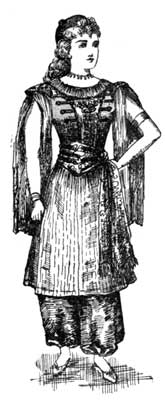 A TURKISH MAIDEN.
A TURKISH MAIDEN.
The first pantomime or harlequinade was played in England in 1717, and the earliest illustration of an English harlequin in the dress now familiar to us, is to be found in a sketch of Bartholomew Fair, dated 1721. Of the characters of columbine, pantaloon, and clown, we have no contemporary drawings. Of the French ballet dancers of this period there are some carefully-executed plates in Planché's "Cyclopædia of Costume." They are all represented in long, and sometimes in trained skirts. The first example of the abbreviated ballet skirt, reaching to the knee, is given in the portrait of an actress personating Le Zephyr, about the middle of the 18th century. The peasant costume of various nations has also been adapted to stage purposes with excellent effect.
The late Hon. Lewis Wingfield devoted much time to designing the stage dresses of the Victorian era, and Madame Alias—who has also passed away—provided the costumes in Mr. Calvert's revival of Henry VIII., and was also responsible for dressing many of the Alhambra ballets and the plays at London and provincial theatres. Madame Bernhardt, Miss Ellen Terry, Mrs. Langtry, Sir Henry Irving, and the late Sir Augustus Harris have also brought their influence, money, and taste to bear on correct stage costume, with the result that we have had many sumptuously-dressed revivals and new plays, which otherwise might have sunk into oblivion. Such spectacles as are often to be seen at our leading Metropolitan theatres and music halls, if they fail to touch the public fancy, mean absolute and irretrievable ruin to their promoters; and when it is remembered that many thousands are spent annually in staging theatrical enterprises, before a single seat is booked, it will at once be seen what enormous sums must[Pg 90] be involved in furthering dramatic interests. The public, who have for the last sixty years been catered for so generously, are sometimes apt to overlook the difficulties with which the scenic artist has to contend.
It would be impossible within the circumscribed limit of a single volume to minutely describe even the most notable theatrical costumes of the last half century, but a few of the most effective floral costumes will be appended for the benefit of those who desire to introduce them into various entertainments.
The steady patronage of Her Majesty the Queen and the Royal Family have done much to remove any prejudices which existed against the drama, and as a powerful auxiliary to education the stage is rapidly gaining ground. Dull, indeed, must the theatre-goer be if he leaves without having assimilated some valuable lesson. To Shakespeare we owe many ideal types of womanhood, all the more precious now that some of the weaker sex, in an insatiable desire for progress, sometimes neglect those lesser arts which in the past proved to them a shield and buckler. The classical and historical pieces allow us to live again in scenes which occurred when the world was young, and convince us, though the tastes of the people were simpler, human nature, with its passions and aspirations, has changed but little. Who can deny the moral influence of such plays as "The Sign of the Cross," "Hypatia," "The Daughters of Babylon," "Virginius," or those of the Robertson school, of which "Caste" and "Ours" are examples? A love of music is not considered a marked trait of the English nation, yet have not Italian and comic opera stimulated a desire for a concord of sweet sounds among all classes of the community? Such plays as "Patience" and the "Mikado" have developed our instinct for colour and form, and we are taught the value of industry and restraint when we watch well-trained actors, capable of controlling every gesture, and of charming us with their well-modulated voices. Our lives are cheered by viewing the comic side of things, and on our clothing and household possessions, the stage has also laid a refining hand.
The bodice and skirt of red accordion, pleated mousseline de soie, the petals of the flower and belt in bright red silk. Large silk poppies appear on the shoulders and bust, and one of extra size is used for a head-dress. With this costume neat black shoes and silk stockings should be worn, and a palm-leaf fan covered with poppies and foliage should be carried.
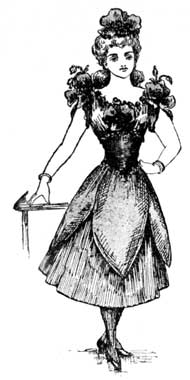 A POPPY.
A POPPY.
Corsage and skirt of white pleated Valenciennes lace mounted on green silk. A full berthe of the flowers. White lace hat entirely covered with these blooms, and fan to correspond.
Gown of pink satin, veiled with tulle and flecked with rose buds. A ruche of moss roses at the hem of the skirt and on the bodice. A Dolly Varden hat trimmed with moss roses and pink ribbon.
Dress of shot pink and white satin, embroidered or painted with clusters and trails of wild roses and foliage. Skirt edged with full ruche of pink tulle studded with roses, and corsage trimmed to correspond. Coiffure poudré dressed with small basket of roses and pink ribbon.
Gown with Watteau train of white satin[Pg 91] edged with leaveless roses, chains of the same flowers carried across the front of the dress, and outlining the square-cut bodice, and elbow sleeves. Ruffles of lace. A wreath of white roses in the powdered hair, and a crook decorated with flowers and ribbon streamers.
Gown of cream-coloured brocade, with design in shaded roses and foliage, trimmed with garland of roses of different tints embedded in tulle. Décolleté corsage trimmed to correspond, and a damask rose worn in the hair.
Dress of pale blue satin, veiled with green tulle. Trails of forget-me-nots, poppies, marguerites, buttercups, and grass depending from the waist-belt to edge of skirt, and bodice trimmed to correspond. A Leghorn hat garnished with wild flowers, grass, and blue ribbons.
Greek dress of white crêpe de Chine, embroidered in classical design with silver. In front diagonal trails of gardenias and their dark foliage arranged from the right shoulder to left side of dress. The hair bound with silver bands. A shower bouquet to correspond.
Gown of emerald green satin appliquéd with velvet shamrocks of a darker shade. The stomacher a large trefoil in emeralds, and the short sleeves cut to resemble the Irish emblem. Corsage veiled with green tulle strewn with tiny shamrocks, and a coronet of the same in the hair.
High dress of eau de nil satin. The skirt edged with a wreath of thistles, which are also embroidered in a bold design on the front of gown and bodice. Satin hat trimmed with thistles and ribbon, and black staff tied with thistles and ribbon streamers.
Gown of yellow accordion, pleated chiffon finished on the skirt with trails of flowers from the waist to hem of the skirt, interspersed with the seed pods commonly known as blow-aways. The bodice of pleated yellow chiffon with dandelions across the berthe and clusters on the shoulders. A wreath and aigrette to correspond.
Dress of white satin, veiled with mauve chiffon, flecked with iris petals. Trails of mauve and white flowers tied with bows of satin in alternate shades, and carried across the skirt. Square cut corsage to correspond, and elbow sleeves. A muslin cap trimmed with the same flowers. Powdered hair.
Gown of cream satin brocaded with mauve and white lilac, Marie Antoinette, white chiffon fichu, and cap trimmed with clusters of shaded lilac and foliage. Elbow sleeves with chiffon ruffles. The white satin fan painted to correspond, and caught by a flower châtelaine. The hair dressed with the same flowers, and a twisted scarf of mauve and white chiffon.
End of Project Gutenberg's The Evolution of Fashion, by Florence Mary Gardiner
*** END OF THIS PROJECT GUTENBERG EBOOK THE EVOLUTION OF FASHION ***
***** This file should be named 34845-h.htm or 34845-h.zip *****
This and all associated files of various formats will be found in:
http://www.gutenberg.org/3/4/8/4/34845/
Produced by Meredith Bach and the Online Distributed
Proofreading Team at http://www.pgdp.net
Updated editions will replace the previous one--the old editions
will be renamed.
Creating the works from public domain print editions means that no
one owns a United States copyright in these works, so the Foundation
(and you!) can copy and distribute it in the United States without
permission and without paying copyright royalties. Special rules,
set forth in the General Terms of Use part of this license, apply to
copying and distributing Project Gutenberg-tm electronic works to
protect the PROJECT GUTENBERG-tm concept and trademark. Project
Gutenberg is a registered trademark, and may not be used if you
charge for the eBooks, unless you receive specific permission. If you
do not charge anything for copies of this eBook, complying with the
rules is very easy. You may use this eBook for nearly any purpose
such as creation of derivative works, reports, performances and
research. They may be modified and printed and given away--you may do
practically ANYTHING with public domain eBooks. Redistribution is
subject to the trademark license, especially commercial
redistribution.
*** START: FULL LICENSE ***
THE FULL PROJECT GUTENBERG LICENSE
PLEASE READ THIS BEFORE YOU DISTRIBUTE OR USE THIS WORK
To protect the Project Gutenberg-tm mission of promoting the free
distribution of electronic works, by using or distributing this work
(or any other work associated in any way with the phrase "Project
Gutenberg"), you agree to comply with all the terms of the Full Project
Gutenberg-tm License (available with this file or online at
http://gutenberg.org/license).
Section 1. General Terms of Use and Redistributing Project Gutenberg-tm
electronic works
1.A. By reading or using any part of this Project Gutenberg-tm
electronic work, you indicate that you have read, understand, agree to
and accept all the terms of this license and intellectual property
(trademark/copyright) agreement. If you do not agree to abide by all
the terms of this agreement, you must cease using and return or destroy
all copies of Project Gutenberg-tm electronic works in your possession.
If you paid a fee for obtaining a copy of or access to a Project
Gutenberg-tm electronic work and you do not agree to be bound by the
terms of this agreement, you may obtain a refund from the person or
entity to whom you paid the fee as set forth in paragraph 1.E.8.
1.B. "Project Gutenberg" is a registered trademark. It may only be
used on or associated in any way with an electronic work by people who
agree to be bound by the terms of this agreement. There are a few
things that you can do with most Project Gutenberg-tm electronic works
even without complying with the full terms of this agreement. See
paragraph 1.C below. There are a lot of things you can do with Project
Gutenberg-tm electronic works if you follow the terms of this agreement
and help preserve free future access to Project Gutenberg-tm electronic
works. See paragraph 1.E below.
1.C. The Project Gutenberg Literary Archive Foundation ("the Foundation"
or PGLAF), owns a compilation copyright in the collection of Project
Gutenberg-tm electronic works. Nearly all the individual works in the
collection are in the public domain in the United States. If an
individual work is in the public domain in the United States and you are
located in the United States, we do not claim a right to prevent you from
copying, distributing, performing, displaying or creating derivative
works based on the work as long as all references to Project Gutenberg
are removed. Of course, we hope that you will support the Project
Gutenberg-tm mission of promoting free access to electronic works by
freely sharing Project Gutenberg-tm works in compliance with the terms of
this agreement for keeping the Project Gutenberg-tm name associated with
the work. You can easily comply with the terms of this agreement by
keeping this work in the same format with its attached full Project
Gutenberg-tm License when you share it without charge with others.
1.D. The copyright laws of the place where you are located also govern
what you can do with this work. Copyright laws in most countries are in
a constant state of change. If you are outside the United States, check
the laws of your country in addition to the terms of this agreement
before downloading, copying, displaying, performing, distributing or
creating derivative works based on this work or any other Project
Gutenberg-tm work. The Foundation makes no representations concerning
the copyright status of any work in any country outside the United
States.
1.E. Unless you have removed all references to Project Gutenberg:
1.E.1. The following sentence, with active links to, or other immediate
access to, the full Project Gutenberg-tm License must appear prominently
whenever any copy of a Project Gutenberg-tm work (any work on which the
phrase "Project Gutenberg" appears, or with which the phrase "Project
Gutenberg" is associated) is accessed, displayed, performed, viewed,
copied or distributed:
This eBook is for the use of anyone anywhere at no cost and with
almost no restrictions whatsoever. You may copy it, give it away or
re-use it under the terms of the Project Gutenberg License included
with this eBook or online at www.gutenberg.org
1.E.2. If an individual Project Gutenberg-tm electronic work is derived
from the public domain (does not contain a notice indicating that it is
posted with permission of the copyright holder), the work can be copied
and distributed to anyone in the United States without paying any fees
or charges. If you are redistributing or providing access to a work
with the phrase "Project Gutenberg" associated with or appearing on the
work, you must comply either with the requirements of paragraphs 1.E.1
through 1.E.7 or obtain permission for the use of the work and the
Project Gutenberg-tm trademark as set forth in paragraphs 1.E.8 or
1.E.9.
1.E.3. If an individual Project Gutenberg-tm electronic work is posted
with the permission of the copyright holder, your use and distribution
must comply with both paragraphs 1.E.1 through 1.E.7 and any additional
terms imposed by the copyright holder. Additional terms will be linked
to the Project Gutenberg-tm License for all works posted with the
permission of the copyright holder found at the beginning of this work.
1.E.4. Do not unlink or detach or remove the full Project Gutenberg-tm
License terms from this work, or any files containing a part of this
work or any other work associated with Project Gutenberg-tm.
1.E.5. Do not copy, display, perform, distribute or redistribute this
electronic work, or any part of this electronic work, without
prominently displaying the sentence set forth in paragraph 1.E.1 with
active links or immediate access to the full terms of the Project
Gutenberg-tm License.
1.E.6. You may convert to and distribute this work in any binary,
compressed, marked up, nonproprietary or proprietary form, including any
word processing or hypertext form. However, if you provide access to or
distribute copies of a Project Gutenberg-tm work in a format other than
"Plain Vanilla ASCII" or other format used in the official version
posted on the official Project Gutenberg-tm web site (www.gutenberg.org),
you must, at no additional cost, fee or expense to the user, provide a
copy, a means of exporting a copy, or a means of obtaining a copy upon
request, of the work in its original "Plain Vanilla ASCII" or other
form. Any alternate format must include the full Project Gutenberg-tm
License as specified in paragraph 1.E.1.
1.E.7. Do not charge a fee for access to, viewing, displaying,
performing, copying or distributing any Project Gutenberg-tm works
unless you comply with paragraph 1.E.8 or 1.E.9.
1.E.8. You may charge a reasonable fee for copies of or providing
access to or distributing Project Gutenberg-tm electronic works provided
that
- You pay a royalty fee of 20% of the gross profits you derive from
the use of Project Gutenberg-tm works calculated using the method
you already use to calculate your applicable taxes. The fee is
owed to the owner of the Project Gutenberg-tm trademark, but he
has agreed to donate royalties under this paragraph to the
Project Gutenberg Literary Archive Foundation. Royalty payments
must be paid within 60 days following each date on which you
prepare (or are legally required to prepare) your periodic tax
returns. Royalty payments should be clearly marked as such and
sent to the Project Gutenberg Literary Archive Foundation at the
address specified in Section 4, "Information about donations to
the Project Gutenberg Literary Archive Foundation."
- You provide a full refund of any money paid by a user who notifies
you in writing (or by e-mail) within 30 days of receipt that s/he
does not agree to the terms of the full Project Gutenberg-tm
License. You must require such a user to return or
destroy all copies of the works possessed in a physical medium
and discontinue all use of and all access to other copies of
Project Gutenberg-tm works.
- You provide, in accordance with paragraph 1.F.3, a full refund of any
money paid for a work or a replacement copy, if a defect in the
electronic work is discovered and reported to you within 90 days
of receipt of the work.
- You comply with all other terms of this agreement for free
distribution of Project Gutenberg-tm works.
1.E.9. If you wish to charge a fee or distribute a Project Gutenberg-tm
electronic work or group of works on different terms than are set
forth in this agreement, you must obtain permission in writing from
both the Project Gutenberg Literary Archive Foundation and Michael
Hart, the owner of the Project Gutenberg-tm trademark. Contact the
Foundation as set forth in Section 3 below.
1.F.
1.F.1. Project Gutenberg volunteers and employees expend considerable
effort to identify, do copyright research on, transcribe and proofread
public domain works in creating the Project Gutenberg-tm
collection. Despite these efforts, Project Gutenberg-tm electronic
works, and the medium on which they may be stored, may contain
"Defects," such as, but not limited to, incomplete, inaccurate or
corrupt data, transcription errors, a copyright or other intellectual
property infringement, a defective or damaged disk or other medium, a
computer virus, or computer codes that damage or cannot be read by
your equipment.
1.F.2. LIMITED WARRANTY, DISCLAIMER OF DAMAGES - Except for the "Right
of Replacement or Refund" described in paragraph 1.F.3, the Project
Gutenberg Literary Archive Foundation, the owner of the Project
Gutenberg-tm trademark, and any other party distributing a Project
Gutenberg-tm electronic work under this agreement, disclaim all
liability to you for damages, costs and expenses, including legal
fees. YOU AGREE THAT YOU HAVE NO REMEDIES FOR NEGLIGENCE, STRICT
LIABILITY, BREACH OF WARRANTY OR BREACH OF CONTRACT EXCEPT THOSE
PROVIDED IN PARAGRAPH 1.F.3. YOU AGREE THAT THE FOUNDATION, THE
TRADEMARK OWNER, AND ANY DISTRIBUTOR UNDER THIS AGREEMENT WILL NOT BE
LIABLE TO YOU FOR ACTUAL, DIRECT, INDIRECT, CONSEQUENTIAL, PUNITIVE OR
INCIDENTAL DAMAGES EVEN IF YOU GIVE NOTICE OF THE POSSIBILITY OF SUCH
DAMAGE.
1.F.3. LIMITED RIGHT OF REPLACEMENT OR REFUND - If you discover a
defect in this electronic work within 90 days of receiving it, you can
receive a refund of the money (if any) you paid for it by sending a
written explanation to the person you received the work from. If you
received the work on a physical medium, you must return the medium with
your written explanation. The person or entity that provided you with
the defective work may elect to provide a replacement copy in lieu of a
refund. If you received the work electronically, the person or entity
providing it to you may choose to give you a second opportunity to
receive the work electronically in lieu of a refund. If the second copy
is also defective, you may demand a refund in writing without further
opportunities to fix the problem.
1.F.4. Except for the limited right of replacement or refund set forth
in paragraph 1.F.3, this work is provided to you 'AS-IS' WITH NO OTHER
WARRANTIES OF ANY KIND, EXPRESS OR IMPLIED, INCLUDING BUT NOT LIMITED TO
WARRANTIES OF MERCHANTIBILITY OR FITNESS FOR ANY PURPOSE.
1.F.5. Some states do not allow disclaimers of certain implied
warranties or the exclusion or limitation of certain types of damages.
If any disclaimer or limitation set forth in this agreement violates the
law of the state applicable to this agreement, the agreement shall be
interpreted to make the maximum disclaimer or limitation permitted by
the applicable state law. The invalidity or unenforceability of any
provision of this agreement shall not void the remaining provisions.
1.F.6. INDEMNITY - You agree to indemnify and hold the Foundation, the
trademark owner, any agent or employee of the Foundation, anyone
providing copies of Project Gutenberg-tm electronic works in accordance
with this agreement, and any volunteers associated with the production,
promotion and distribution of Project Gutenberg-tm electronic works,
harmless from all liability, costs and expenses, including legal fees,
that arise directly or indirectly from any of the following which you do
or cause to occur: (a) distribution of this or any Project Gutenberg-tm
work, (b) alteration, modification, or additions or deletions to any
Project Gutenberg-tm work, and (c) any Defect you cause.
Section 2. Information about the Mission of Project Gutenberg-tm
Project Gutenberg-tm is synonymous with the free distribution of
electronic works in formats readable by the widest variety of computers
including obsolete, old, middle-aged and new computers. It exists
because of the efforts of hundreds of volunteers and donations from
people in all walks of life.
Volunteers and financial support to provide volunteers with the
assistance they need, are critical to reaching Project Gutenberg-tm's
goals and ensuring that the Project Gutenberg-tm collection will
remain freely available for generations to come. In 2001, the Project
Gutenberg Literary Archive Foundation was created to provide a secure
and permanent future for Project Gutenberg-tm and future generations.
To learn more about the Project Gutenberg Literary Archive Foundation
and how your efforts and donations can help, see Sections 3 and 4
and the Foundation web page at http://www.pglaf.org.
Section 3. Information about the Project Gutenberg Literary Archive
Foundation
The Project Gutenberg Literary Archive Foundation is a non profit
501(c)(3) educational corporation organized under the laws of the
state of Mississippi and granted tax exempt status by the Internal
Revenue Service. The Foundation's EIN or federal tax identification
number is 64-6221541. Its 501(c)(3) letter is posted at
http://pglaf.org/fundraising. Contributions to the Project Gutenberg
Literary Archive Foundation are tax deductible to the full extent
permitted by U.S. federal laws and your state's laws.
The Foundation's principal office is located at 4557 Melan Dr. S.
Fairbanks, AK, 99712., but its volunteers and employees are scattered
throughout numerous locations. Its business office is located at
809 North 1500 West, Salt Lake City, UT 84116, (801) 596-1887, email
business@pglaf.org. Email contact links and up to date contact
information can be found at the Foundation's web site and official
page at http://pglaf.org
For additional contact information:
Dr. Gregory B. Newby
Chief Executive and Director
gbnewby@pglaf.org
Section 4. Information about Donations to the Project Gutenberg
Literary Archive Foundation
Project Gutenberg-tm depends upon and cannot survive without wide
spread public support and donations to carry out its mission of
increasing the number of public domain and licensed works that can be
freely distributed in machine readable form accessible by the widest
array of equipment including outdated equipment. Many small donations
($1 to $5,000) are particularly important to maintaining tax exempt
status with the IRS.
The Foundation is committed to complying with the laws regulating
charities and charitable donations in all 50 states of the United
States. Compliance requirements are not uniform and it takes a
considerable effort, much paperwork and many fees to meet and keep up
with these requirements. We do not solicit donations in locations
where we have not received written confirmation of compliance. To
SEND DONATIONS or determine the status of compliance for any
particular state visit http://pglaf.org
While we cannot and do not solicit contributions from states where we
have not met the solicitation requirements, we know of no prohibition
against accepting unsolicited donations from donors in such states who
approach us with offers to donate.
International donations are gratefully accepted, but we cannot make
any statements concerning tax treatment of donations received from
outside the United States. U.S. laws alone swamp our small staff.
Please check the Project Gutenberg Web pages for current donation
methods and addresses. Donations are accepted in a number of other
ways including checks, online payments and credit card donations.
To donate, please visit: http://pglaf.org/donate
Section 5. General Information About Project Gutenberg-tm electronic
works.
Professor Michael S. Hart is the originator of the Project Gutenberg-tm
concept of a library of electronic works that could be freely shared
with anyone. For thirty years, he produced and distributed Project
Gutenberg-tm eBooks with only a loose network of volunteer support.
Project Gutenberg-tm eBooks are often created from several printed
editions, all of which are confirmed as Public Domain in the U.S.
unless a copyright notice is included. Thus, we do not necessarily
keep eBooks in compliance with any particular paper edition.
Most people start at our Web site which has the main PG search facility:
http://www.gutenberg.org
This Web site includes information about Project Gutenberg-tm,
including how to make donations to the Project Gutenberg Literary
Archive Foundation, how to help produce our new eBooks, and how to
subscribe to our email newsletter to hear about new eBooks.